 |
Our second big bus ride across South America
through Peru, Chile and Argentina, with a stopover in Venezuela
October 2003
|
This was our route, starting in Lima (after a stopover in Caracas on the way) then through Nazca, Arequipa, Cusco and Lake Titicaca in Peru, Arica and San Pedro de Atacama in Chile, and Salta, Buenos Aires and Mar del Plata in Argentina (about 3,500 miles or 5,600 km, all by bus except for one 240-mile train ride). Unfortunately we had to by-pass Bolivia due to civil unrest there. |
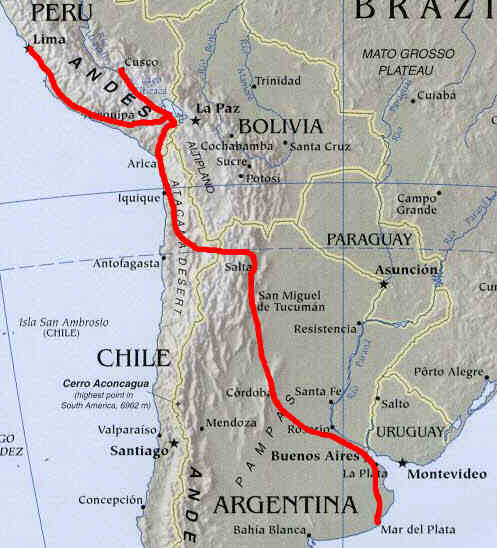
|
Note - prices for hotels are for a double room (not per person) and usually include breakfast; prices for meals are for two, but bus and train prices are per person. |
Caracas, Venezuela
|
Friday 3rd October. We flew to Caracas, Venezuela. We arrived on time and before dark, which was a relief because we'd heard bad things about airport taxi drivers robbing arriving passengers after dark (including dire warnings on the Foreign Office web site). In fact our taxi driver was charming and navigated us faultlessly through the awful traffic jams to the Cumberland Hotel. We walked round the corner to a bar with an armed guard on the door, and had cheese and chorizo sausages with a couple of beers.
Sat 4th. Breakfast always seems to be the best part of the day - the sun is shining and there is the anticipation of exploring a new place. For our day tour of Caracas we walked down to the metro station and got the metro to the centre of town. The metro seems to be the only piece of infrastructure that is still efficient, clean and well-run. We walked round the historic centre of Caracas, clustered around Simon Bolivar Square, and went to see Simon's house which is a lovely restored old colonial house. We returned to the Sabana Grande district and walked back to the hotel down the pedestrian shopping street. |
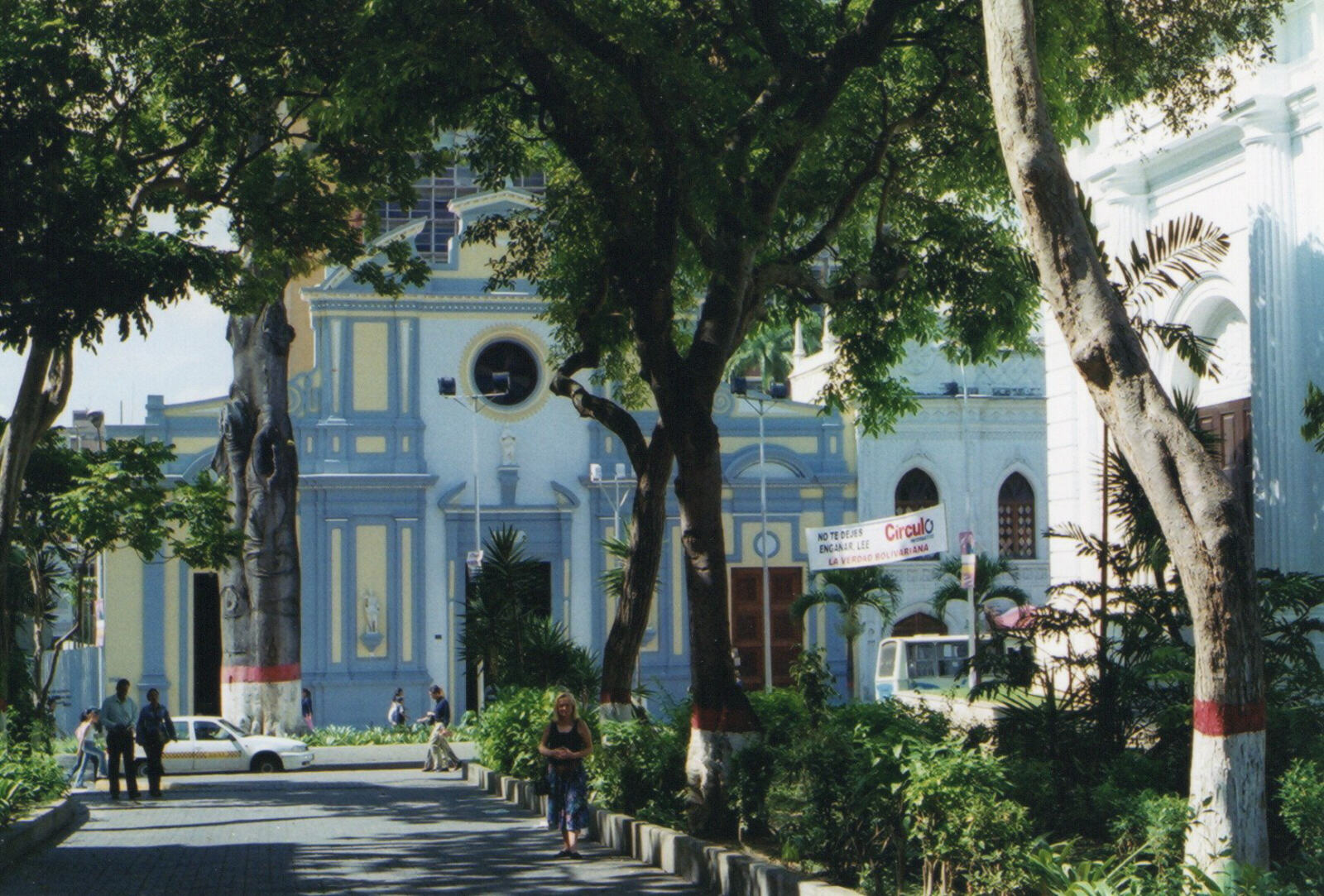
|
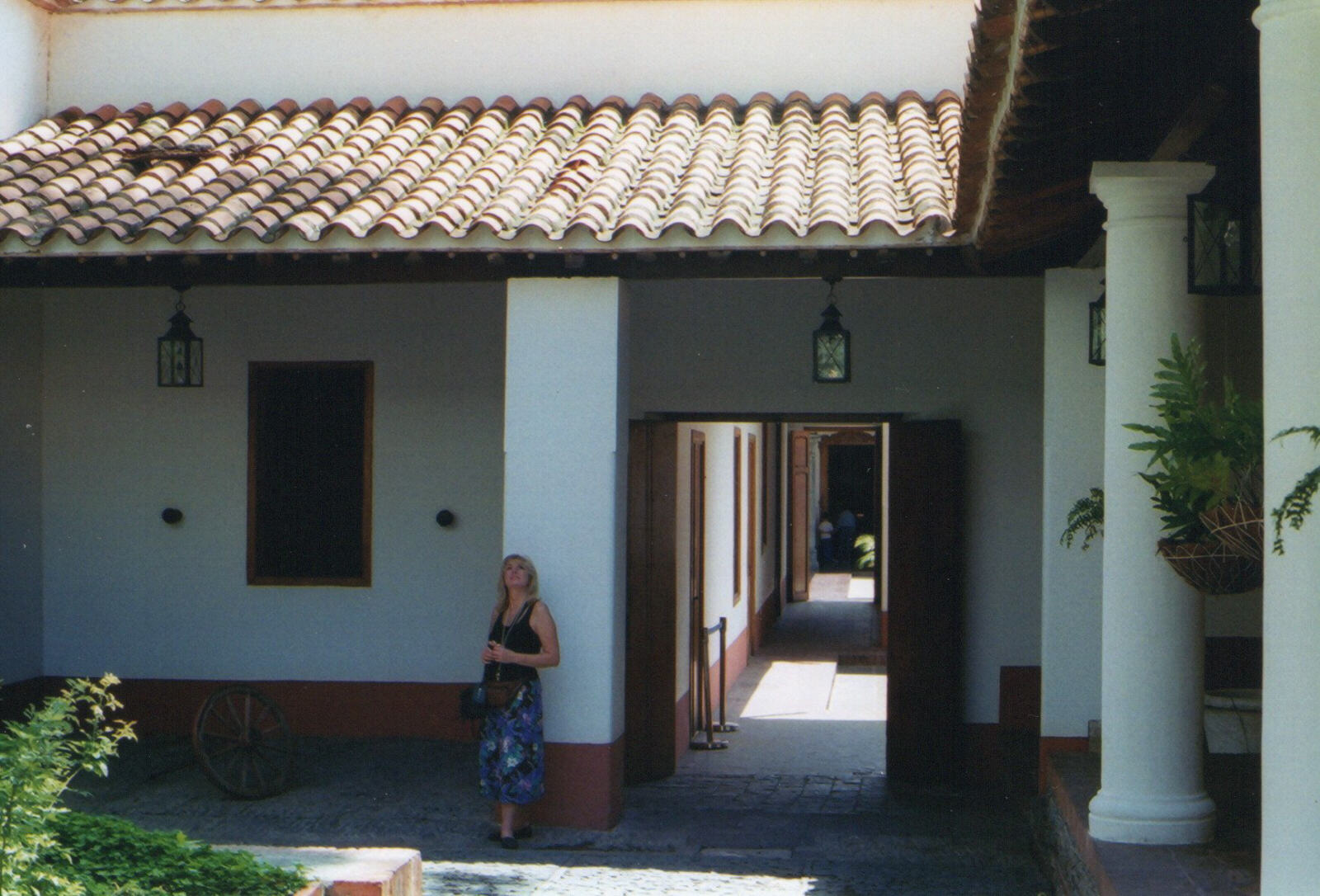
|
We set off for the airport earlier than we needed to, which turned out to be a good thing, because the flight we were booked on didn't exist. This caused a moment of panic as we saw the whole trip crumbling before our eyes, but after some phone calls and to-ing and fro-ing on walkie talkies we were transferred to another flight to Lima on a different airline that left 1½ hours earlier, so our leisurely check-in became a mad scramble to get to the plane before it left. We made it and arrived on the plane hot and sweating and extremely relieved. |
Lima, Peru
|
The flight stopped in Bogota but all we could see of Colombia was a few misty lights in the darkness, and we got to Lima an hour earlier than originally arranged. Our pre-arranged taxi driver turned up and took us to the delightful Antigua Miraflores hotel, which was in a lovely old building and we had a super big room with a kitchen and a jacuzzi. As we drove from the airport through the outskirts of Lima our main impression was a Las-Vegas-style succession of casinos, discotheques and American fast-food restaurants.
Sun 5th. We went on a city tour, including the main square, San Fransisco monastery with its catacombs full of bones and a colourful festival and procession outside, Hucca Pucllana a 4th century Inca archaeological site and Laco Mar a shopping mall at the seaside. |
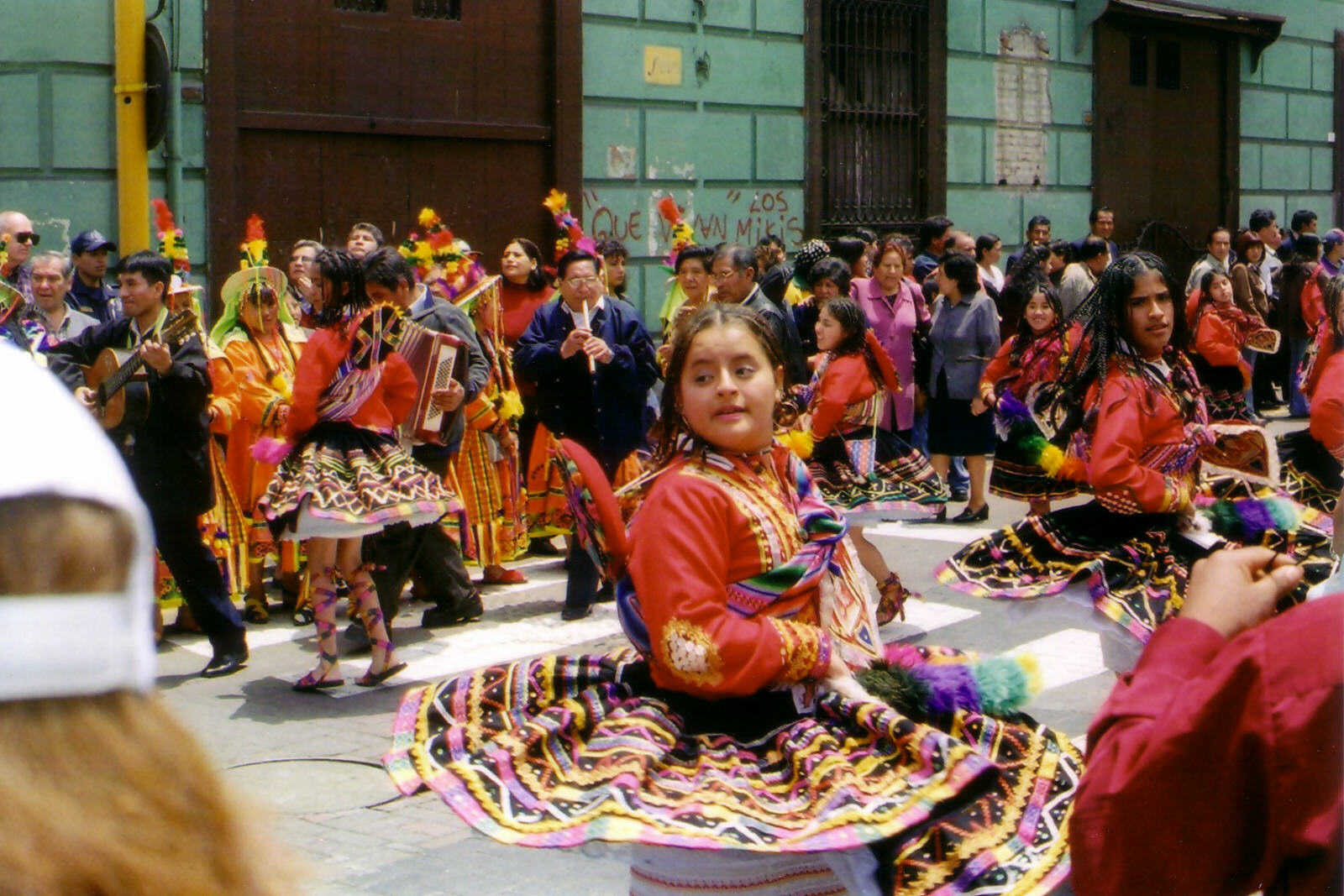
|
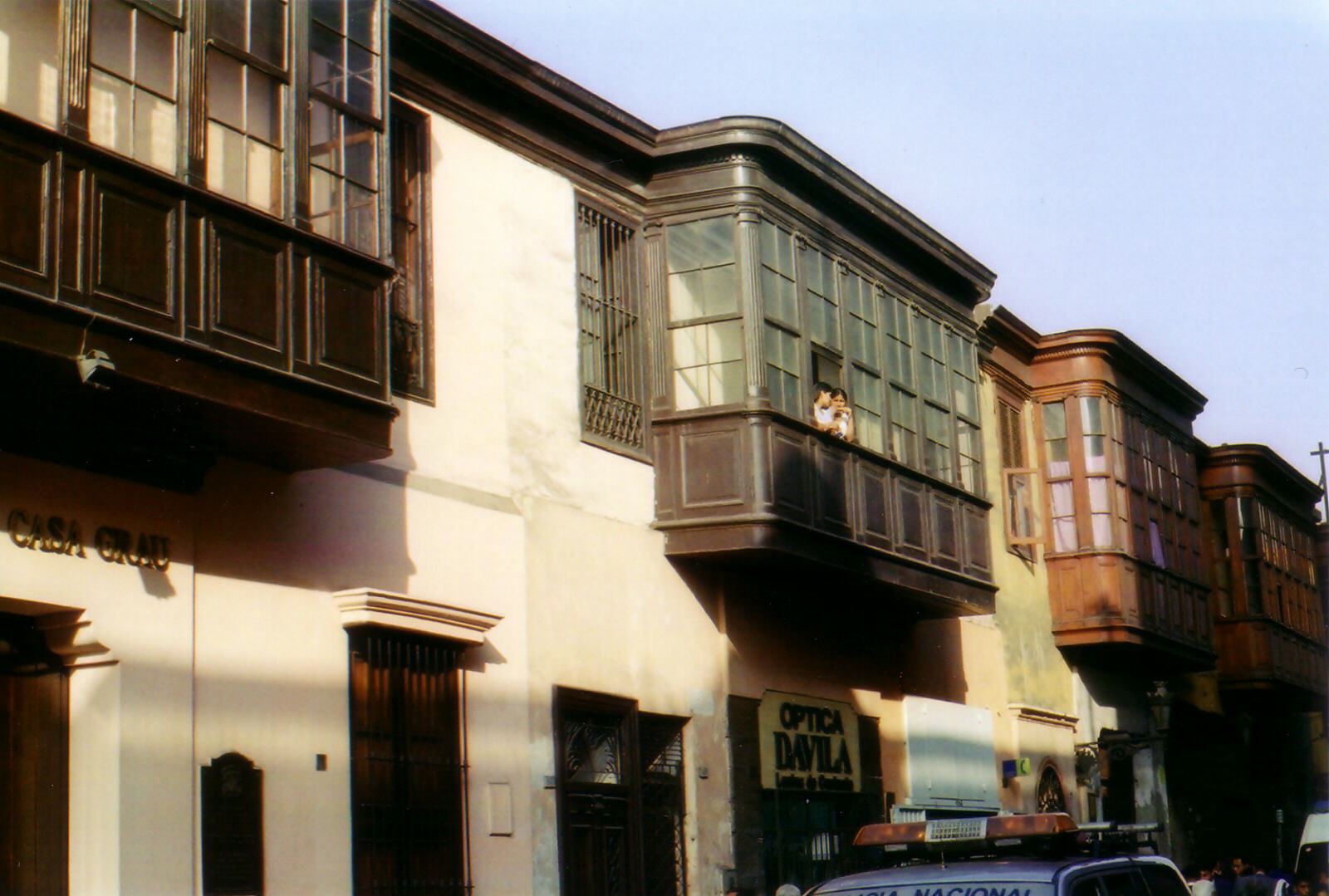
|
For lunch we went round the corner to Buyas de Calerviche restaurant and had the best (strongest!) pisco sours of the trip, then had another walk round the city centre. Lima turned out to be a pleasant surprise, with interesting sights and nice warm sunshine (all the guide books say the climate is really awful with constant dull mist). In the evening we went to the Rosa Nautica restaurant which is in a fabulous position at the end of a pier built out over the Pacific Ocean. Lights underneath the building illuminate the waves swirling below and occasionally a big wave makes the building shake eerily as if an underground train was passing beneath. The food was excellent, beautifully presented and only a little bit expensive. |
Nazca, Peru
|
Mon 6th Oct. We caught the 9am Ormeño line 'Royal Class' bus to Nazca. The bus was extremely comfortable with lots of leg room, and excellent value for $22. They served an airline-style lunch and we had three videos on the 6-hour trip. We sat upstairs on the double-deck luxury bus and watched the bleak Peruvian desert roll by, with miles of sand dunes and grey rocks and dust looking like a huge building site, interspersed with the occasional fertile valley.
When we arrived at Nazca we fell straight into the hands of a tout. He took us to an excellent hotel, the 'Oro Viejo' (old gold) which was small and friendly with nice rooms around a pretty garden, he recommended a restaurant for later, 'Grumpy's' which turned out to be very good, and he rushed us into taking the flight over the Nazca Lines this afternoon in case it was misty tomorrow - this was actually so that we couldn't find out how much he'd overcharged us for the flight which would only have been $35 in the agencies in town. Nevertheless the flight over the lines was great fun, just us and the pilot in a little 3-seater Cessna swooping over the lines etched all over the nearby desert. Of course the pilot concentrated on the lines that depicted animals and birds because they were most photogenic if a bit Disneyland, but the most eerie were the dead straight lines stretching for miles across the plateau and the great triangular patches which are supposed to represent valleys, pointing towards the mountains where the precious rain falls. If you look closely below you can see a hummingbird, in the centre of the picture, with its beak to the left and wings above and below. The lines, or rather line, is etched onto the desert and is believed to be a processional walkway, so for scale imagine people walking along it. The figure is drawn with a single continuous line which starts and ends at the tip of the beak. |
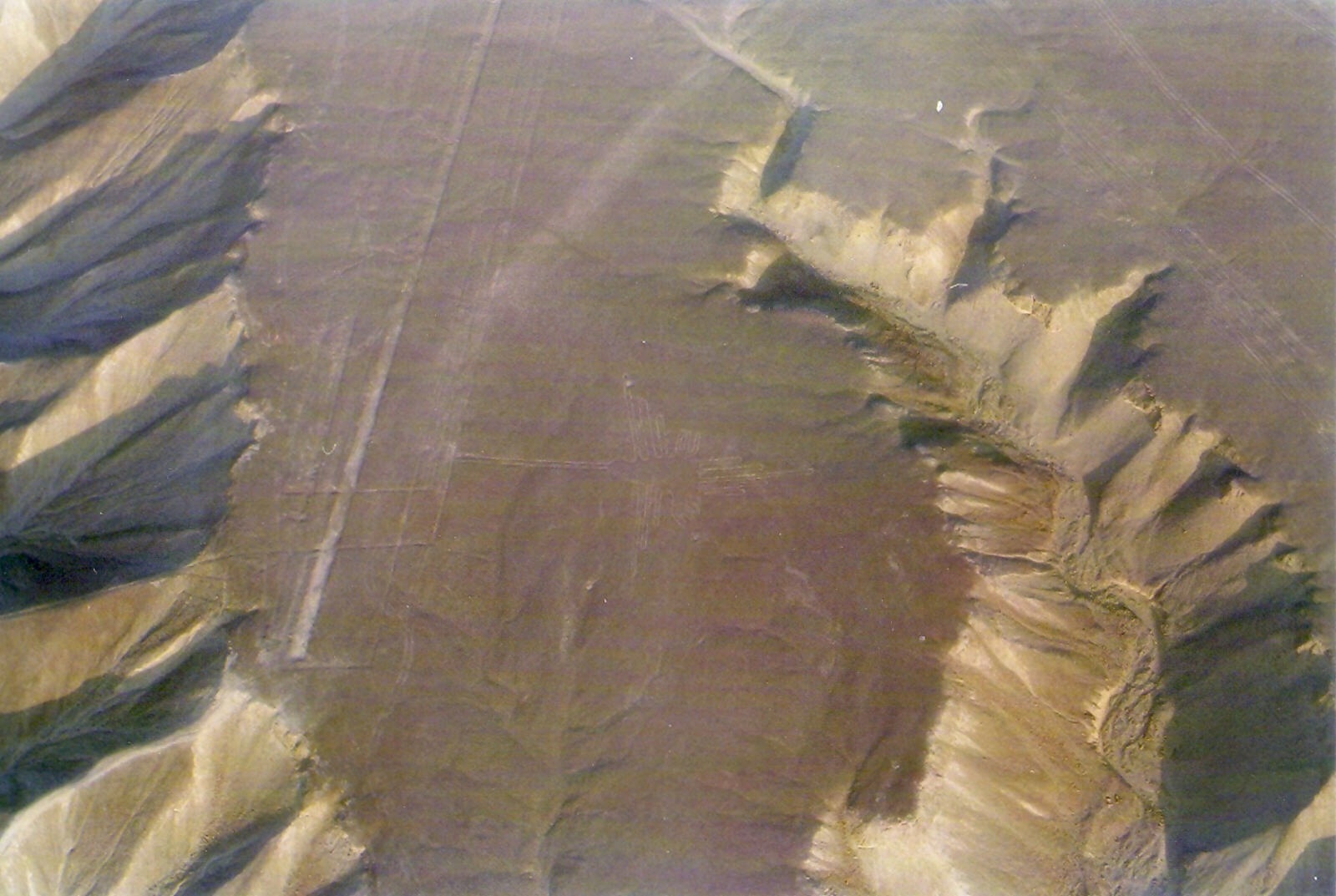
|
Nazca is a pleasant, compact, small town and after a short walk round we had a nice meal at Grumpy's restaurant. As we sat reading through the guest books full of enthusiastic descriptions from earlier travellers who dined there, we noticed that as soon as anyone ordered anything, the owner/waiter dashed out of the restaurant and came back a few minutes later with the ingredients in a black plastic bag! Perhaps we should have gone to the nearby supermarket and bought our meal before we sat down!
Tues 7th Oct. We declined the trip to see the mummies, having seen more than enough bones in the catacombs in Lima. Our next bus did not leave until 3:30 so we had a pleasant, restful morning reading in the hotel's sunny garden and walking around the town, looking at the little market, the street stalls and the huge, ancient American cars and pickups that wheezed their way around the streets. |
Arequipa, Peru
|
When the bus arrived there was initial confusion over double and treble-booked seat numbers, but eventually we got going and had another comfortable ride, managing to sleep for quite a bit of the way. We arrived in Arequipa about midnight and the person who was supposed to meet us and take us to her hotel wasn't there, so we found a taxi driver who chose the rather ordinary Hotel Real for us, but it was too late to start looking for anything else.
Wed 8th Oct. In the morning we found the very pleasant Hostal Nuñez and moved there. We also arranged tomorrow's bus to Cusco and a hotel when we get there, and then we went for a walk around Arequipa which is a pleasant town with a nice relaxed feel to it, with plenty of attractive old houses and churches. We had lunch at a Hare Krishna vegetarian restaurant with the most absent-minded waitress - only half the things we ordered actually arrived - then tea and a piece of deliciously gooey chocolate cake at a café on the main square. The square is very attractive, full of flowering trees and surrounded by colonnaded colonial buildings, colourful houses and the cathedral. |
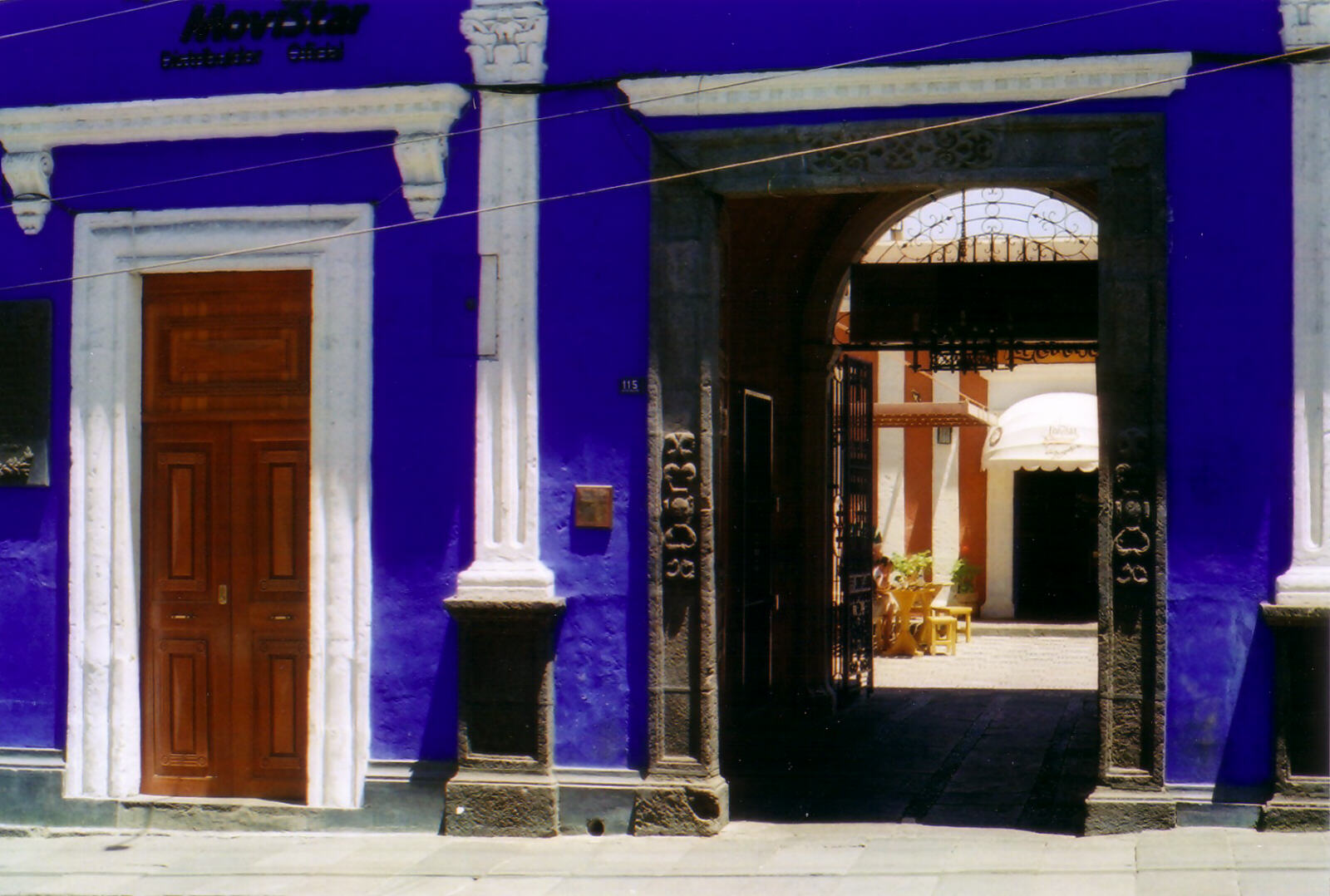
|
In the evening we had a very nice meal at La Quinta, just down the road from our hotel; pepper steak and beef stroganoff, preceded of course by a couple of pisco sours. |
Cusco, Peru
|
Thurs 9th Oct. We had the long (12-hour) bus ride from Arequipa to Cusco via Juliaca and Puno. We chose the daytime bus ride which was longer, so that we could see the view. It was very comfortable but because we have used the same bus line all the way so far we got the same set of videos all over again, and they were pretty awful the first time - mad scientist creates hyper-intelligent sharks, invisible man goes berserk, etc. We saw all we want to see of Juliaca from the bus as it bumped its way through the endless road works, and Puno at least had the benefit of a view of Lake Titicaca.
We arrived at the very friendly Hostal Inca's Peru in Cusco, where they gave us a welcome cup of tea which was most .... welcome. Then we went down to the central square and had an Italian meal, serenaded by a Peruvian pipe band which was the first one we'd seen - we thought they must all be away performing in Guildford High Street. When we unpacked, all sorts of things 'popped' because of the altitude - underarm rollete, suntan cream, and a packet of wet wipes had blown up like a balloon.
Fri 10th Oct. We had a very pleasant day walking around Cusco, which is an attractive, interesting town with old houses with white walls resting on Inca stone foundations in cobbled streets clustered around the main square. There are quite a few tourists and hence quite a few touts for restaurants, tours, shops, etc, but they were not too intrusive or persistent. It was warm and sunny and we had a nice lunch of soup and salads at the Urpi Restaurant, sitting on the balcony overlooking one of the small streets. We walked around the main square admiring the cathedral and the collonades. |
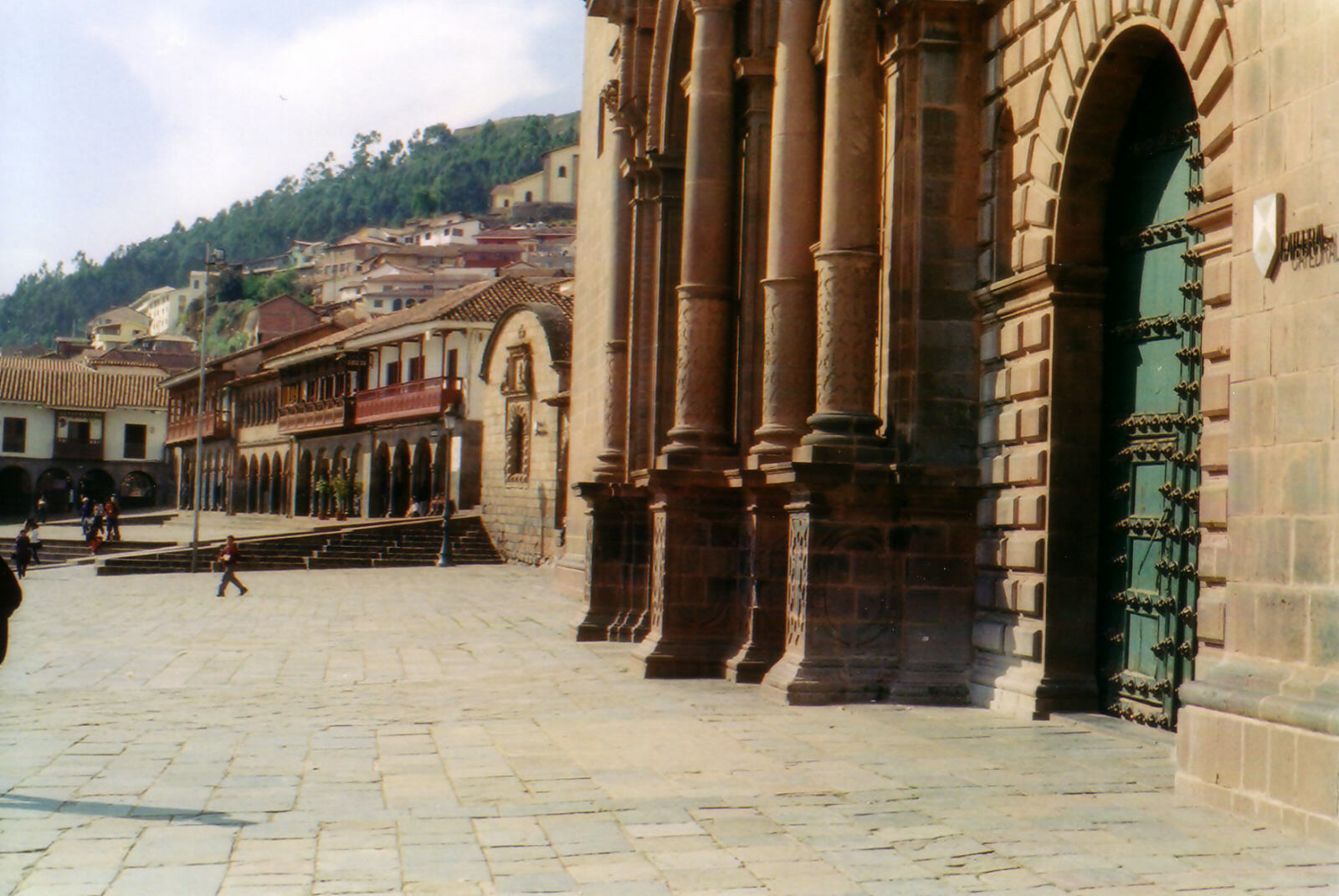
|
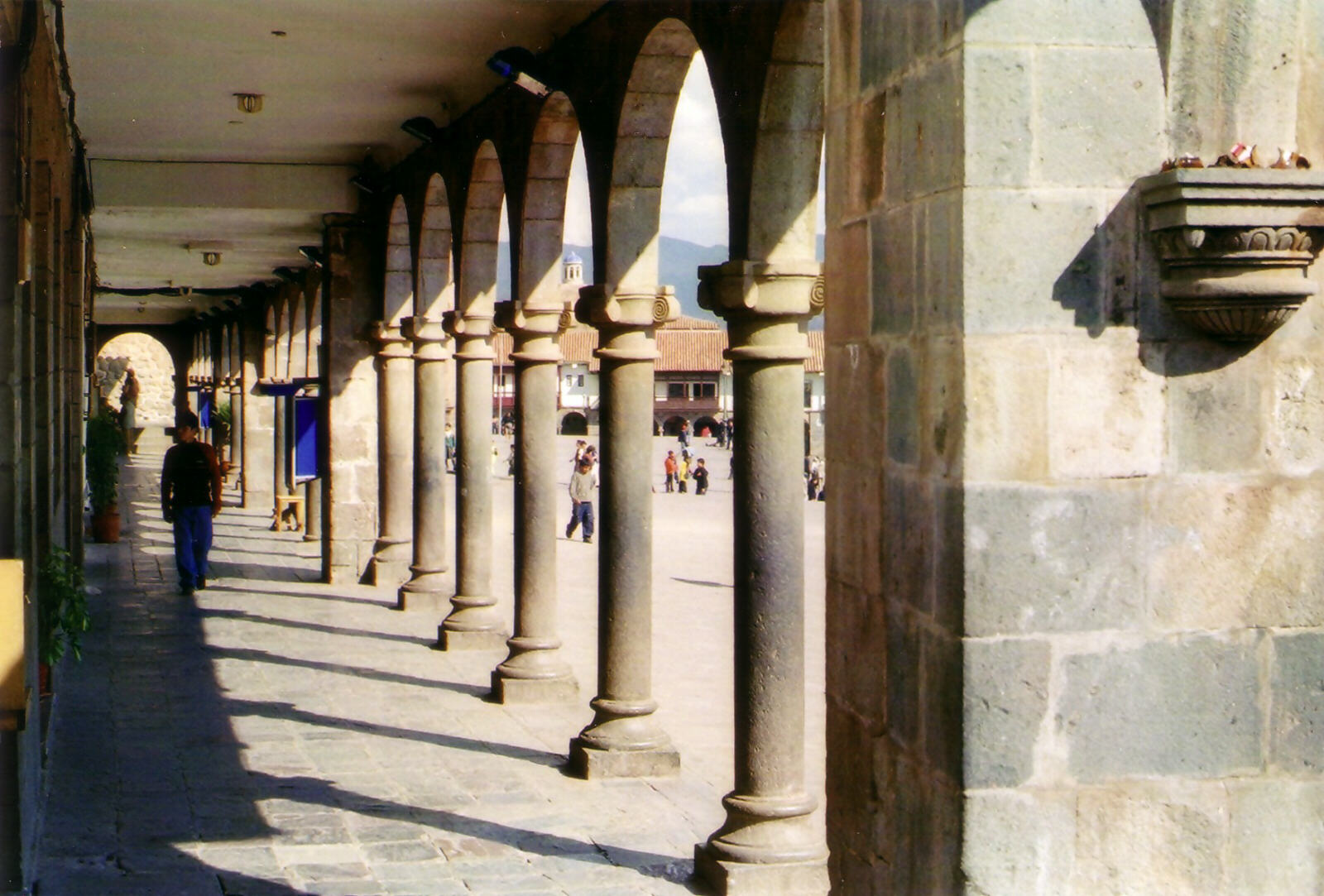
|
Small streets suddenly turn into stairways - Cusco is quite hilly. |
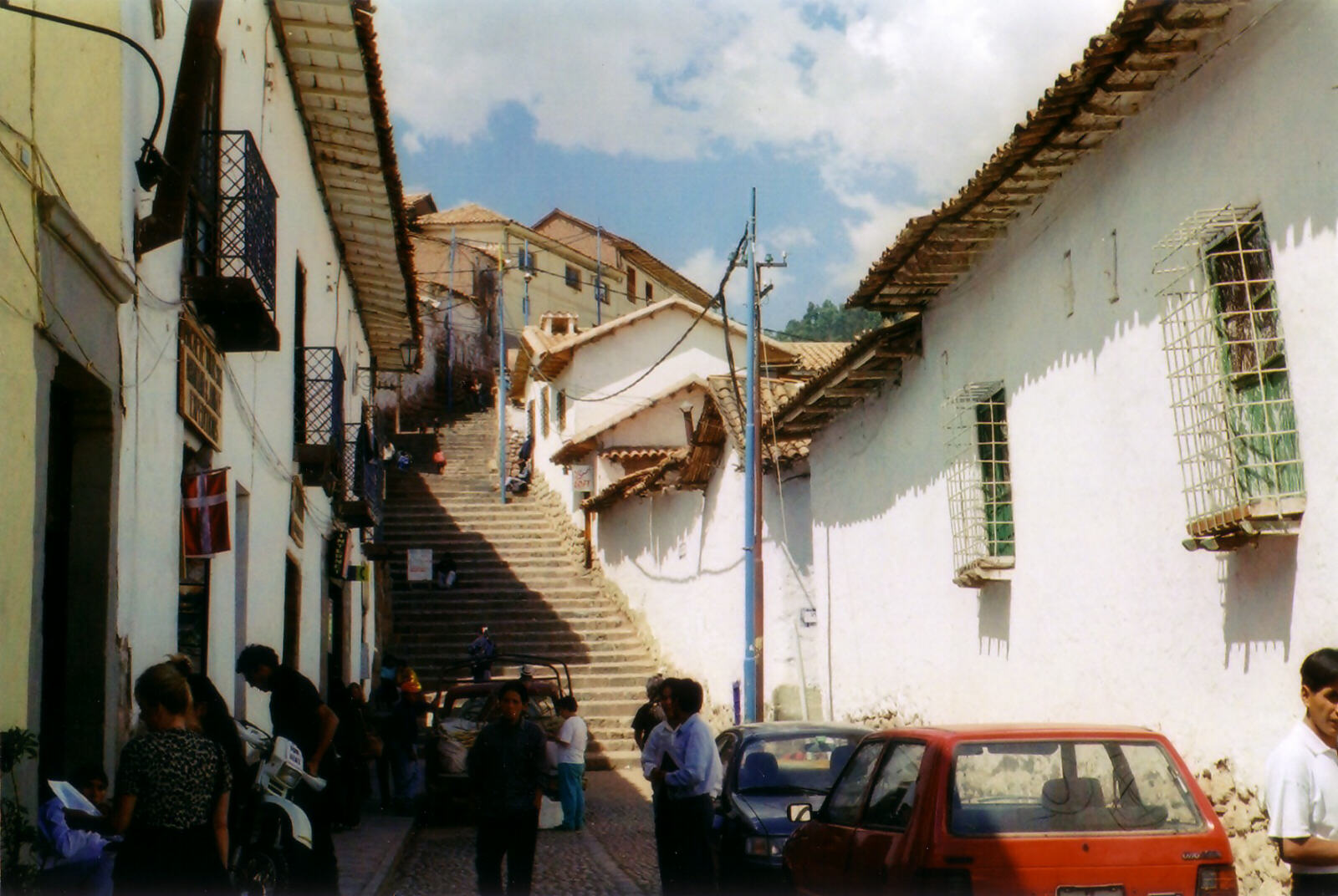
|
We made arrangements to go to Machu Picchu and this was rather a rip off. Of course you expect to pay a lot to go into the site, but they also charge a fortune to get there. There is no road to the nearby town of Aguas Callientes. The standard option is the 'backpackers' train, which is $54 each for the 3-hour train ride. But this gets booked up days in advance, so they try to get you on the 'observatory' train which has windows in the roof for a whopping $90 each. (Or your only other option is to go by helicopter.) Then it's another $9 for the short bus ride up to the site when you get there. Furthermore the timing of the trains means you are faced with a stark choice - try to do the whole thing in one day from Cusco, which only leaves you 4 or 5 hours to rush around Machu Picchu, or stay overnight in Aguas Callientes and have most of a day hanging around there. If you want to revisit Machu Picchu on the second day, you still have to pay another full entrance fee. We found out much later that there is another way to Machu Picchu that they don't tell you about, but it is very inconvenient and still fairly expensive. This involves getting a local bus to the last town on the road, then 'backpacker' carriages on a local train from there, but the local train goes at an incredibly inconvenient time which means the whole expedition takes three days.
In the evening we had a very good Chinese meal in a wonderful location, on a balcony overlooking the main square, with churches and nice old buildings on either side, the illuminated fountain in the middle of the square and the traffic almost colliding at the junction in front of us. |
Aguas Callientes and Machu Picchu
|
Sat 11th Oct. We were up early to get the 6:30 train to Aguas Callientes for Machu Picchu. Despite the exorbitant cost, you have to do it. It was an interesting and picturesque train ride through the mountains and the small farming communities in the valleys. A couple of times the train had to zig zag itself sideways up or down a steep part of the hill. For breakfast we bought two chunky, warm corn-on-the-cobs from a lady at one of the stations on the way.
Aguas Callientes is a pleasant little town around a rushing stream in a steep valley beneath towering mountains. But the most odd thing about it is that the main street is the railway line, which is lined with shops and restaurants. When a local train departs the whole place becomes a mass of people scrambling to get onto the train and hanging onto the doors as it moves off. |
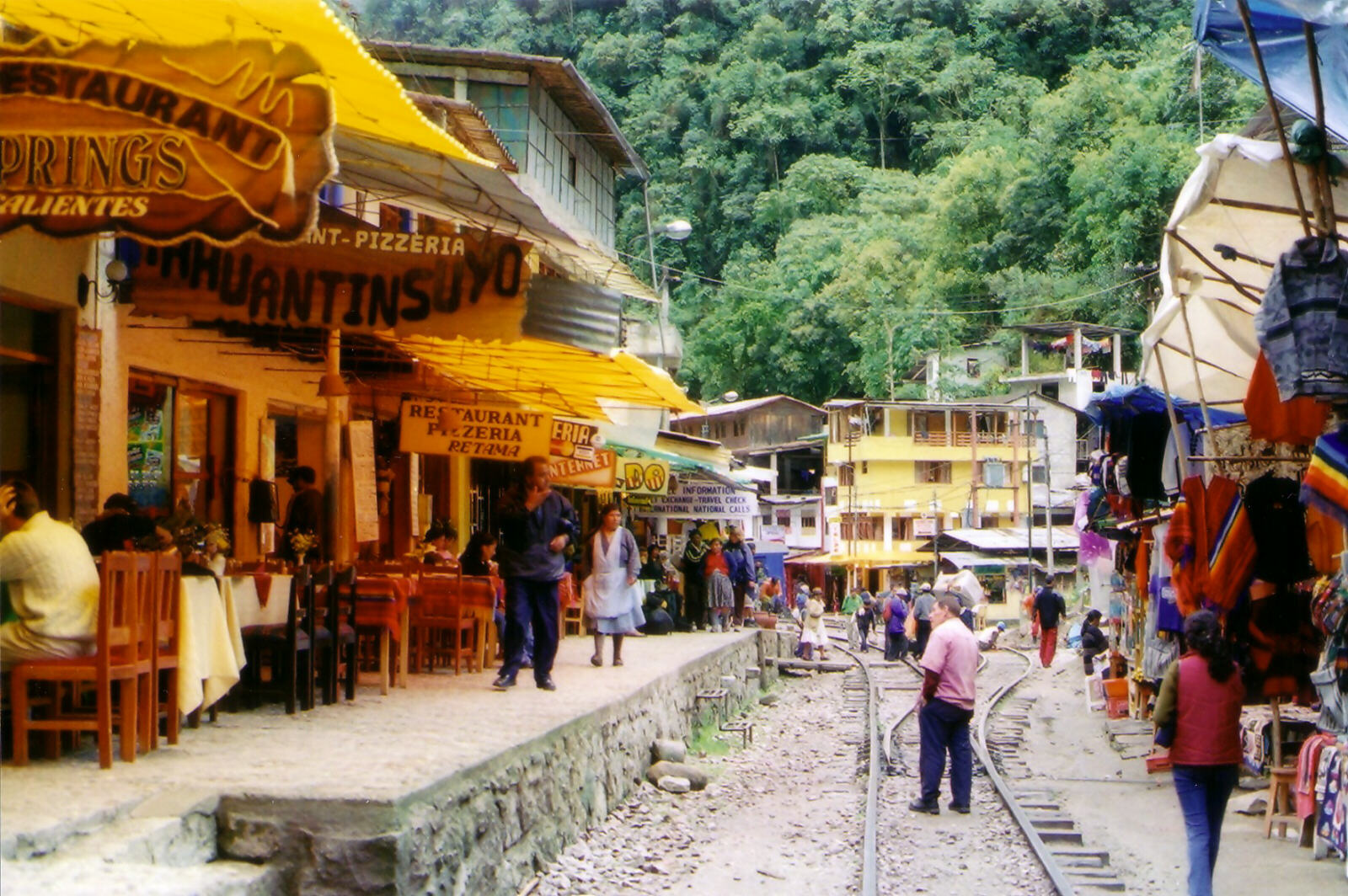
|
We found Joe's Hostal and for $12 stayed in a nice corner room with two windows and the sound of the river thundering by outside. Unfortunately it then started to pour with rain, so we looked around for a while then gave in and sat in a restaurant for a very long lunch. In the evening we walked up the steeply sloping other street in town which is lined with little restaurants, and stopped in one for the local speciality, Cuy Chactano - yes, roasted guinea pig, complete with a little leg and claw, gripping onto the side of the plate. And yes, it did taste like chicken.
Sun 12th Oct. Machu Picchu is magnificent, absolutely stunning. The setting is breathtaking. This was the real high spot of the whole trip, definitely one of our 'seven wonders of the world'. |
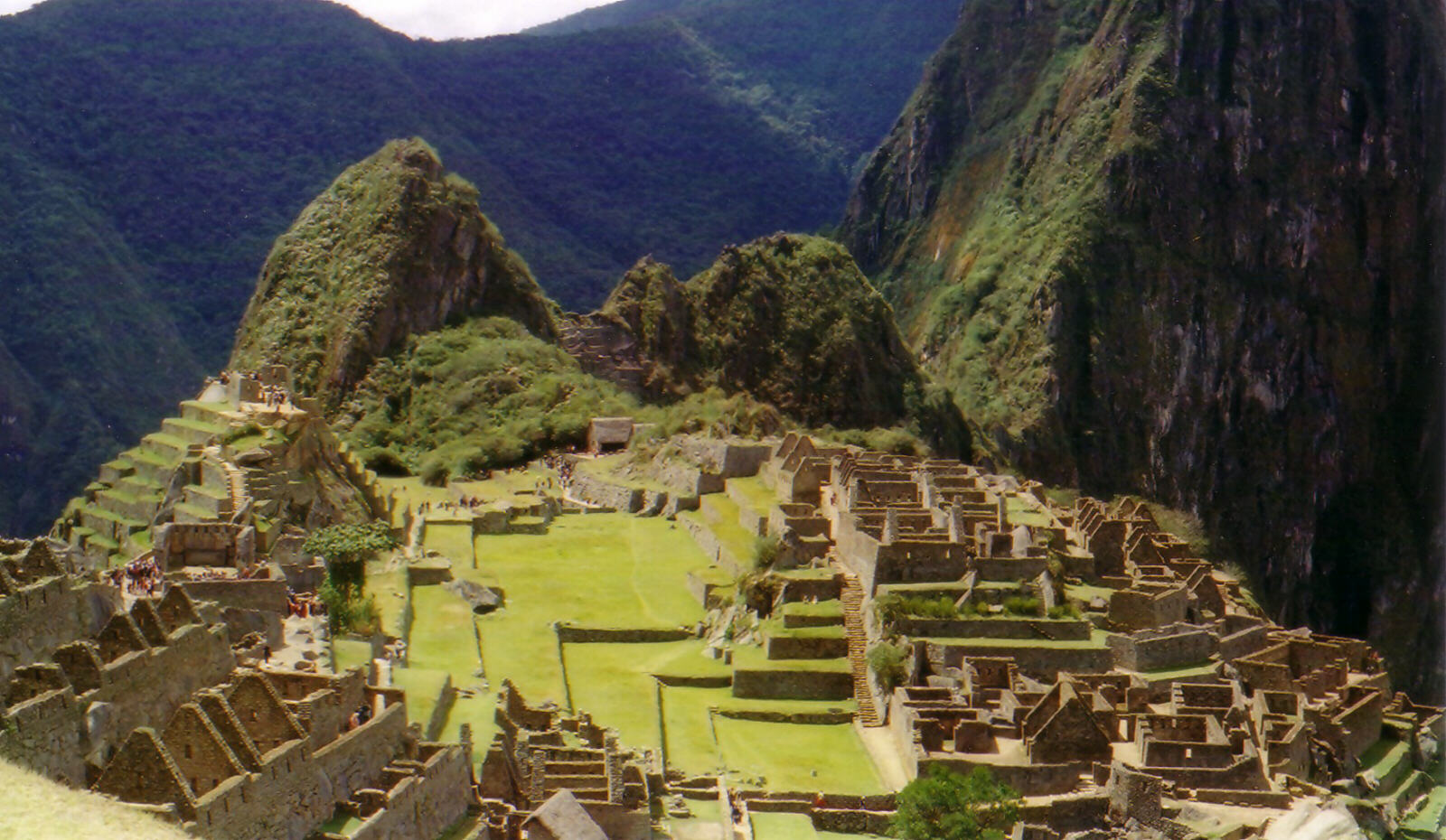
|
And of course, we had to climb up to the top of Huayna Picchu, the big hill on the right, for the magnificent view. |
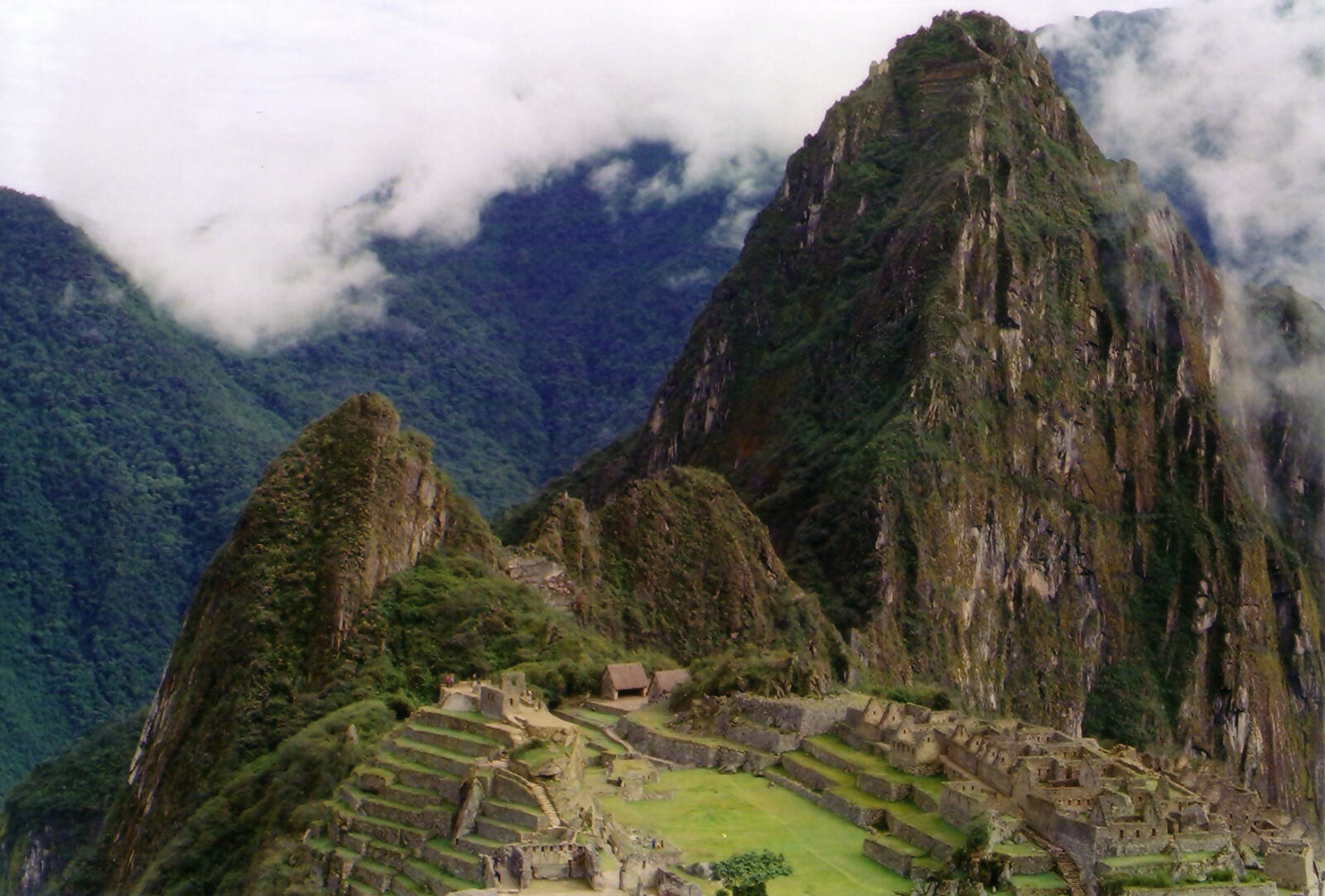
|
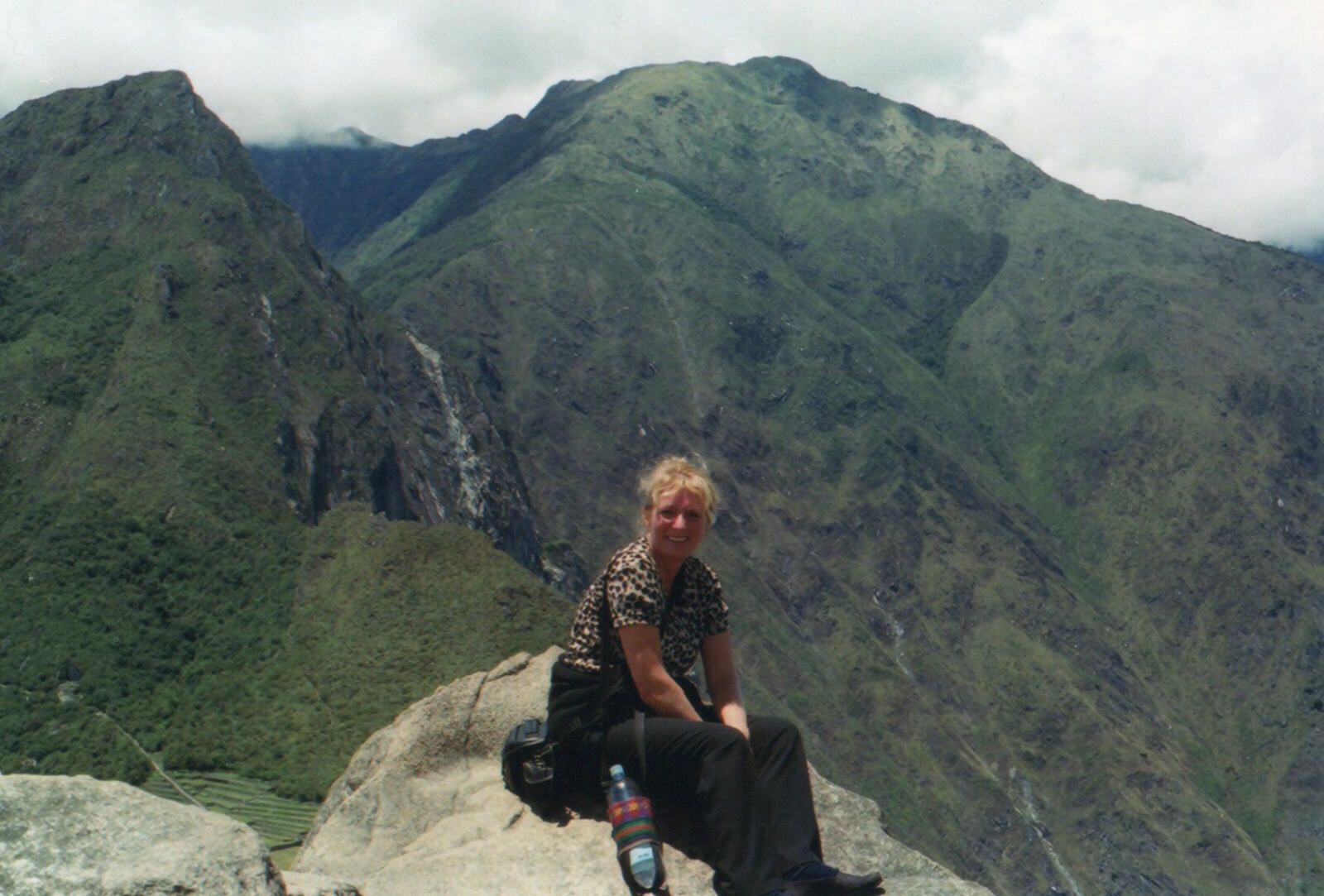
|
The stonework was fantastic, this is Temple Plaza, looking through the window down onto the main plaza, and below is the Temple of the Sun.
|
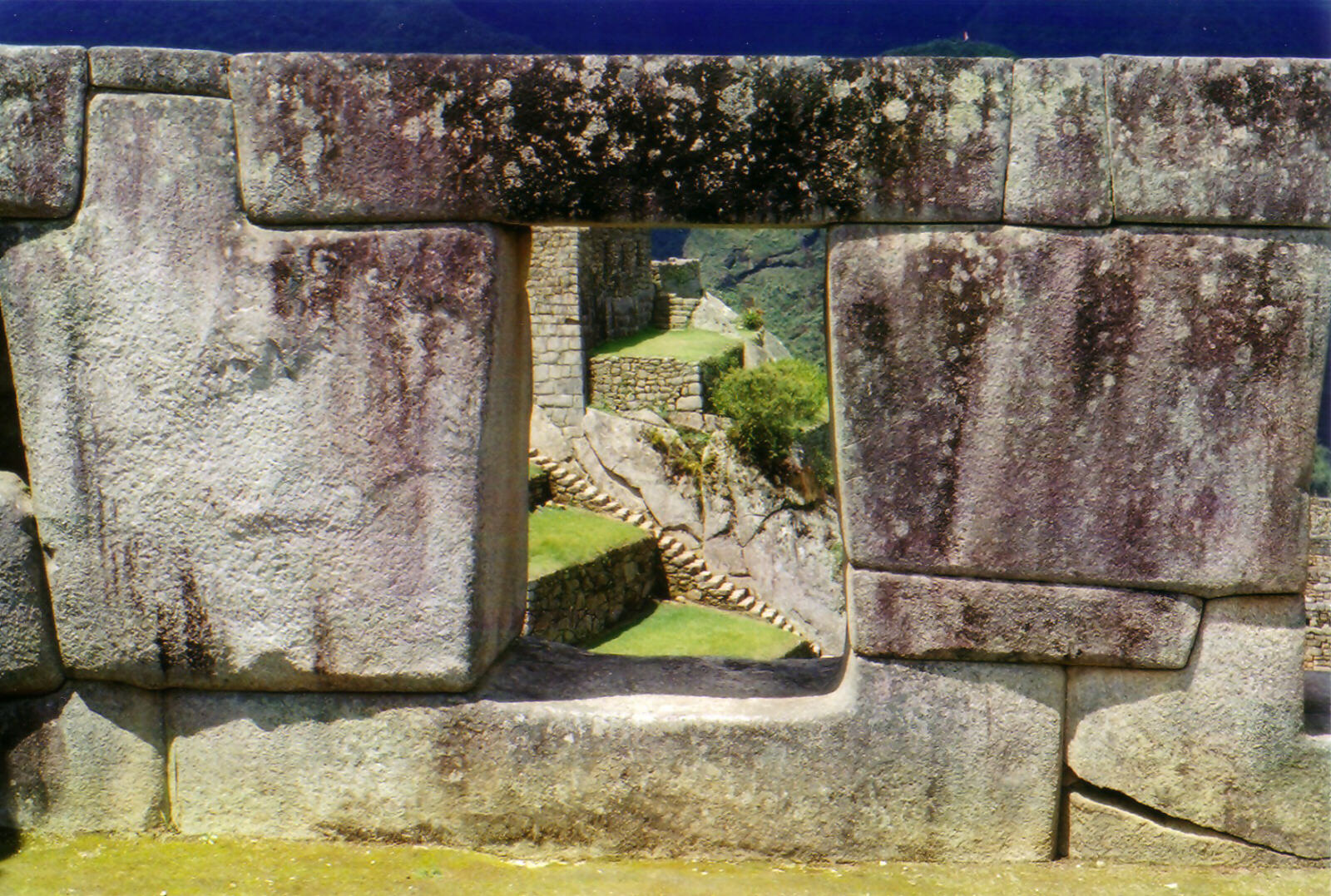
|
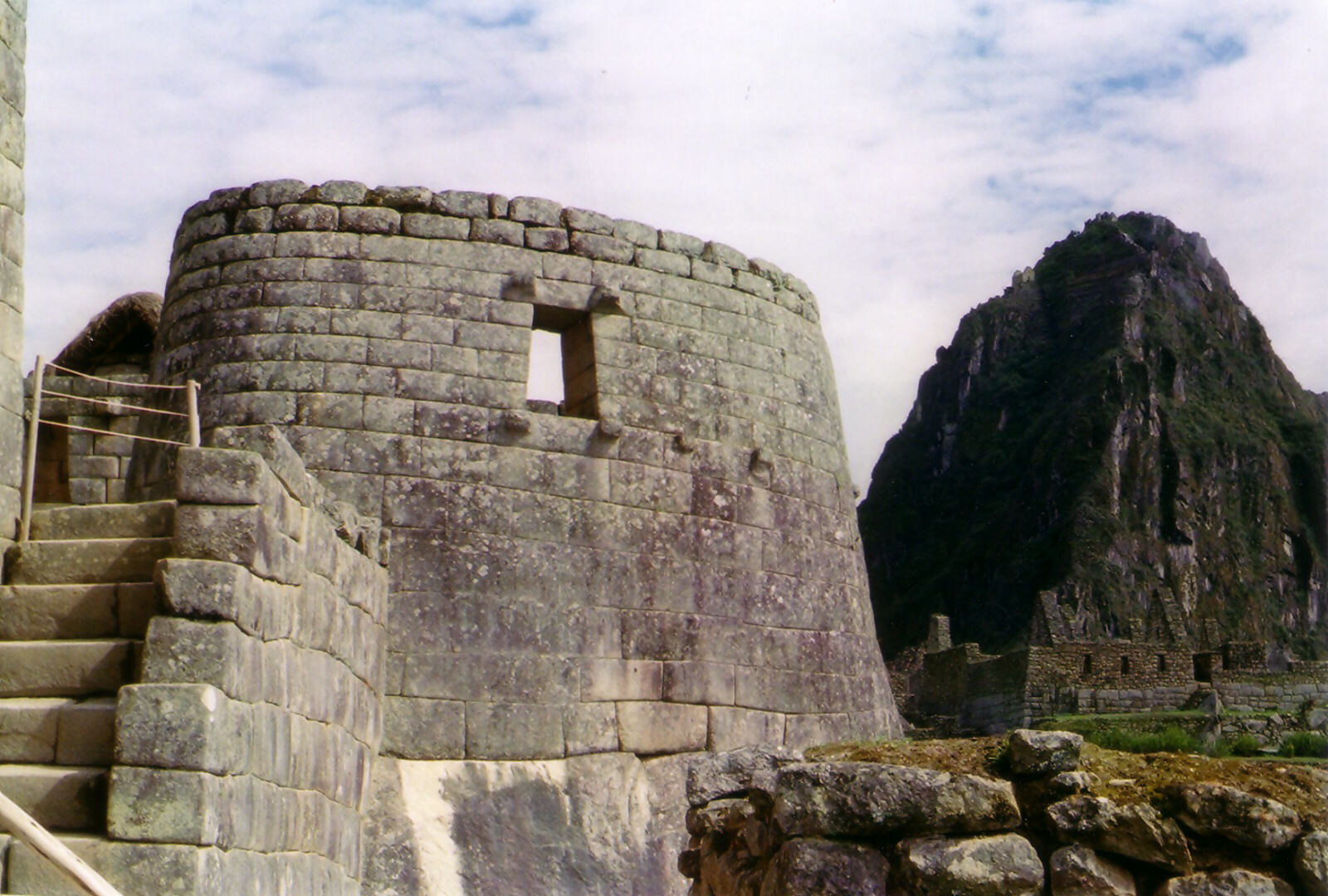
|
We were incredibly lucky with the weather, it was sunny and pleasantly warm - the people who went yesterday in the rain said it was miserable. We were there early and explored the ruins which were peaceful and uncrowded. Then we set out to climb Huayna Picchu, the hill (mountain!) that overlooks Machu Picchu from the north - it was very long and very steep and it turned our legs to jelly, but it was worth it for the fabulous view. By the time we got down again the site was teeming with people, mostly Peruvians on a Sunday afternoon outing. We went back on the bus and the train to Cusco, exhausted but pleased, and in awe of the people who had arrived at Machu Picchu via the difficult Inca Trail in the rain.
Mon 13th Oct. We had a bit of a lie in and a nice relaxed day walking around Cusco, which really is a pleasant place to just wander around. We also went on the tourist 'tram' ride which does a loop into the hills above the town, visiting the big White Christ statue and the Sacsayhuaman Inca ruins. We rounded it off with a perfect evening at Rosy O'Grady's Irish pub, sitting in wooden rocking chairs in front of a log fire, drinking dark beer. |
Puno and Lake Titicaca, Peru
|
Tues 14th Oct. We caught the day bus from Cusco to Puno, arriving about 3pm. It was an interesting ride through the high Andean valleys with lots of small villages and Peruvians in colourful costumes tending their cows and llamas and a shepherdess tending her flock. |
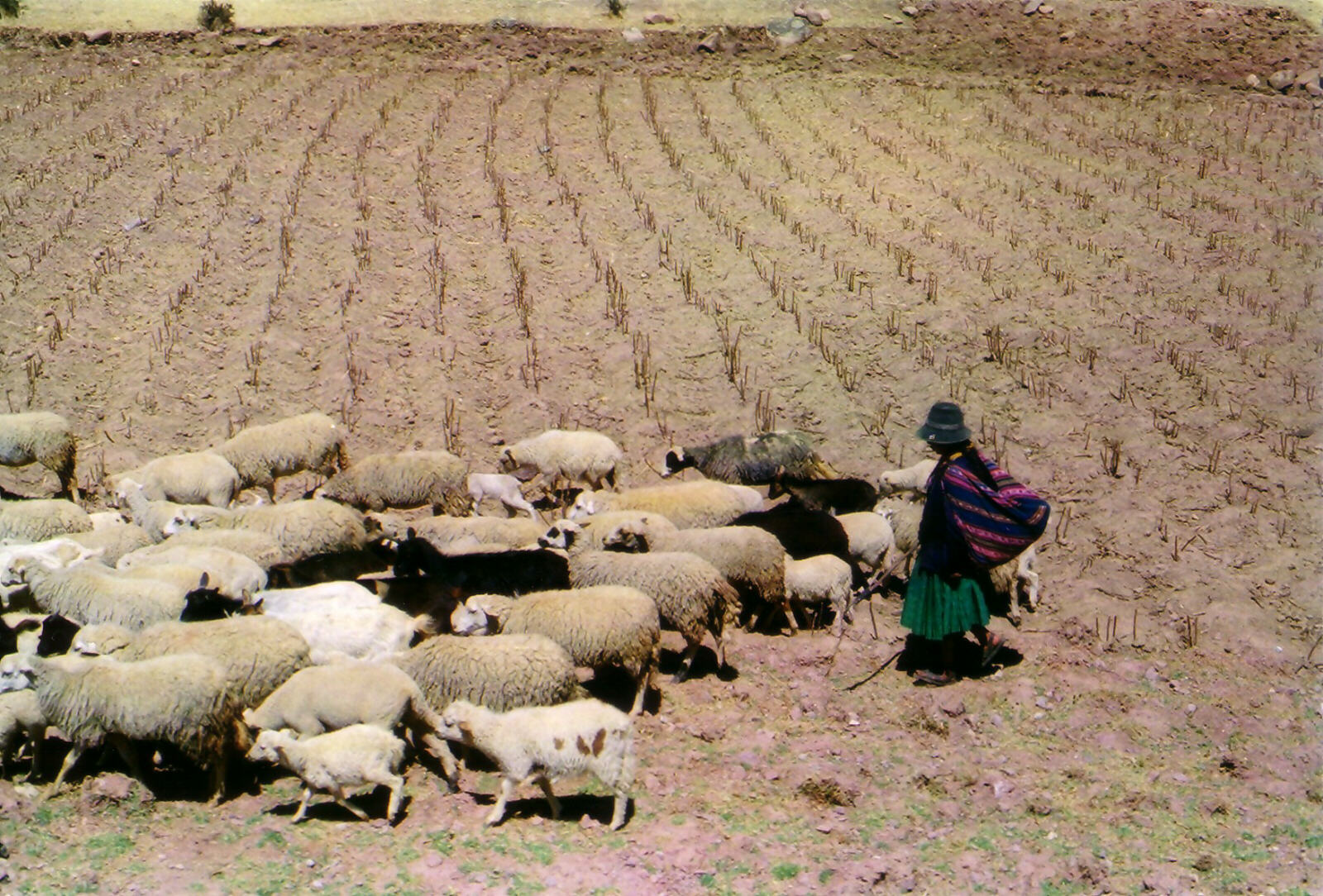
|
The highest pass was over 4,300 metres (14,100 feet) but we didn't have to exert ourselves, the bus did the work. We have discovered that there are four sorts of llamas - two domesticated varieties, alpacas which are used for high quality wool and meat, and llamas which are used as beasts of burden and for meat, and two wild varieties, vicuñas which are small and live at high altitudes and have very high quality wool, and guanacos which are much larger. But we were not expert enough to distinguish which ones these were as we raced past in the bus. Aboard the bus a tout persuaded us to have a look at his hotel, the Ollanda Inn, which was new and good value at $10 for a double room, and only a short walk to the town centre. So we had a short walk to the town centre, which is two nice little plazas connected by 'Gringo Street', a pedestrian way full of restaurants, internet cafés and tourist shops. We had a tasty four-course 'tourist menu' for $3.50 each.
Sheila made the mistake of having a Dramamine on the bus because she thought it was going to be a boring ride (which it wasn't) so she was still dozy and went for a nap in the late afternoon, while I got a motorbike-taxi to the 'Yavari'. This is an old steam ship made in England in 1862, shipped out to Peru in bits and assembled on Lake Titicaca. It was eventually abandoned by the Peruvian navy, but rescued and restored and is now attached to a very up-market hotel just outside Puno. However, you can just walk through the hotel and along the jetty at the back, and a very pleasant and enthusiastic member of the crew will give you a guided tour, which was fascinating.
Weds 15th Oct. We went on the boat trip on Lake Titicaca, visiting the floating islands where the Uros people live in reed huts on islands made of matted reeds (first picture) and ride around in reed boats (second picture), and a 'fixed' island called Taquile with views of the wonderful colour of the lake (third picture). It was fascinating, with a mixture of traditional pre-Spanish culture and dramatic views of the amazingly blue lake. In the distance we could see the mountains of Bolivia, which have now become unattainable due to the civil disturbances going on there. In the evening we strolled down Gringo Street and had yet another good meal. It is difficult to eat badly in Peru. |
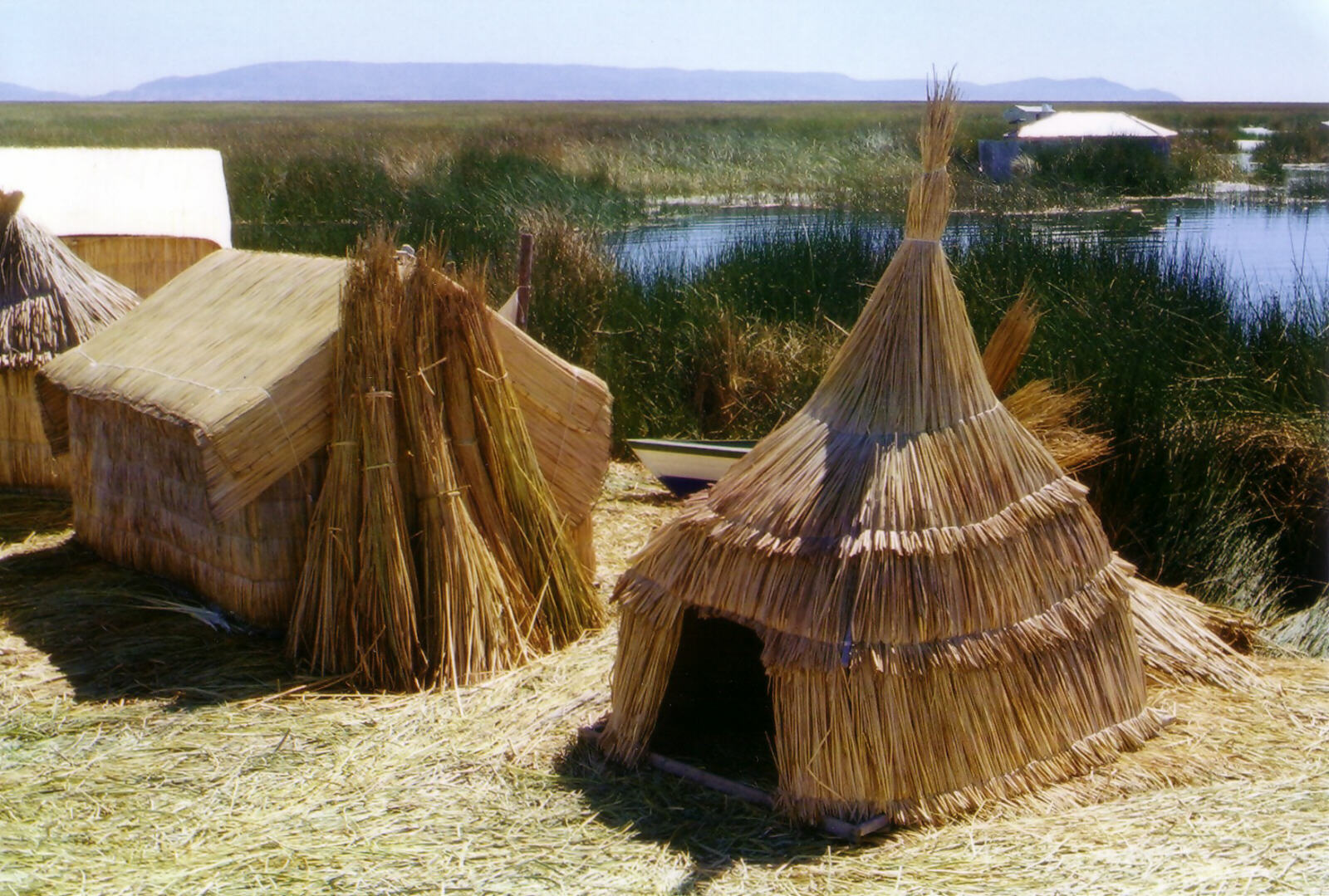
|
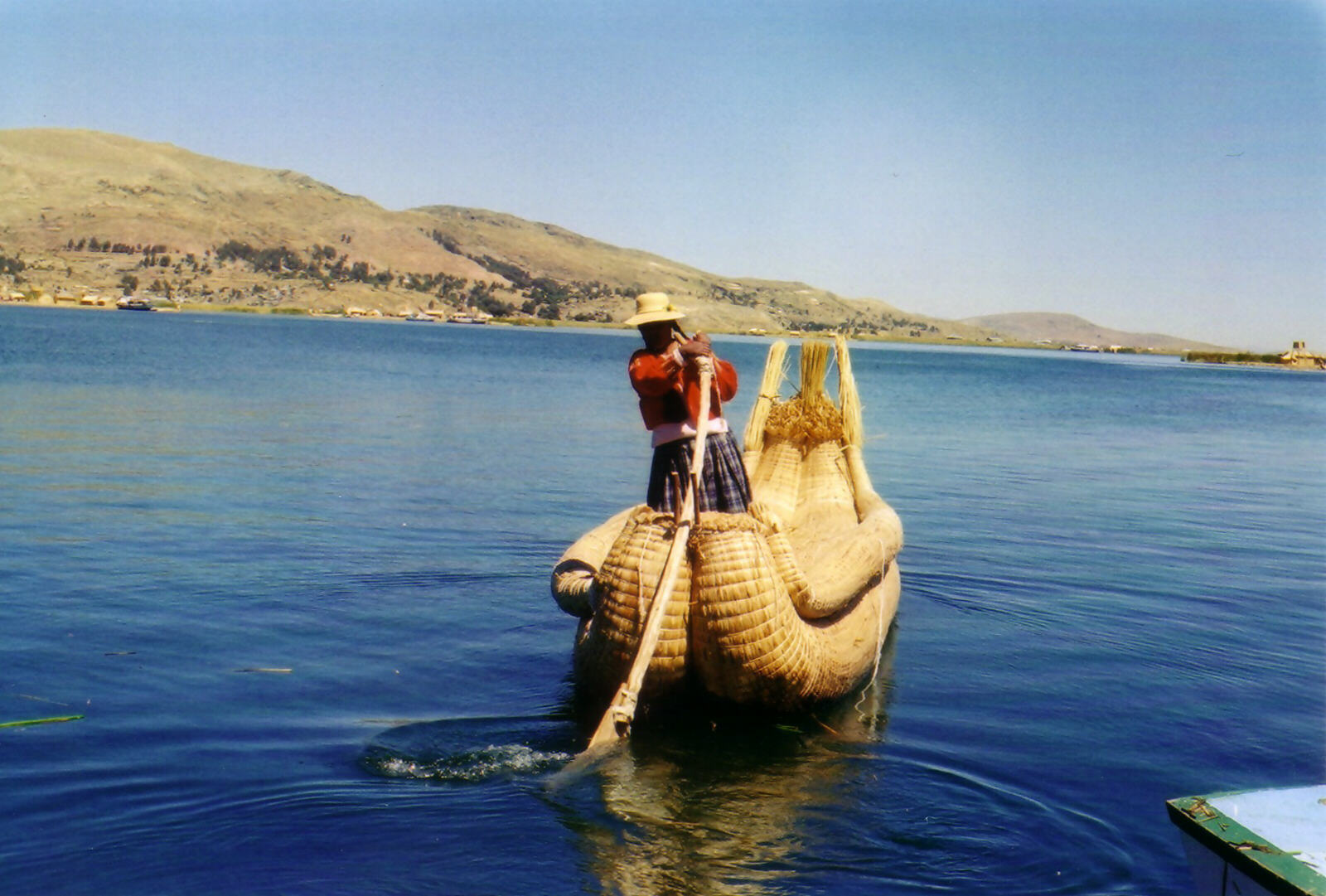
|
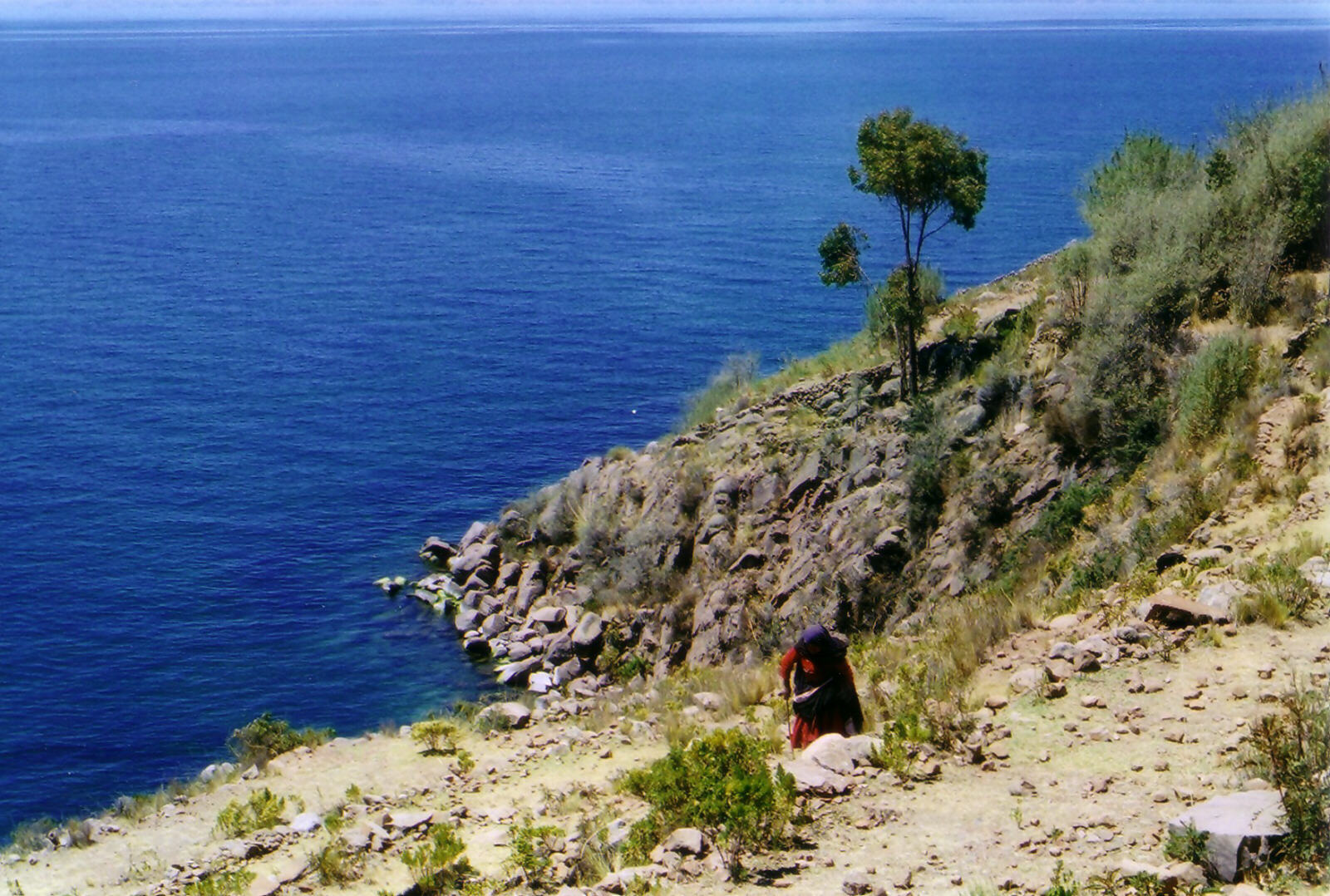
|
Thurs 16th Oct. This is where our carefully-laid plan fell to pieces. Our intention was to travel from Lima to Buenos Aires through Peru and Bolivia. We had completed the Peru section perfectly, but Bolivia was in turmoil, in the grip of serious civil disturbances with borders and roads closed and riots in the streets. So we decided to go round via Chile and come back to Bolivia another year. |
Arica, Chile
|
So we had a big bus ride down the mountain, from a pass near the Bolivian border at 4,500 metres, to Tacna almost at sea level. Our water bottle looked as if it had been stamped on because of the increase in pressure. Unfortunately the bus did not finish at the main bus station, so we had to get a taxi to the international terminal for transport to Arica in Chile. When we got there we were besieged by touts, but we were with two Dutch guys who knew a reputable company so we went with them. Some of the less reputable ones try to smuggle drugs into Chile in the car, then you end up in prison along with the driver. In fact the border crossing was painless and we arrived in Arica without incident. The whole journey from Puno took 12 hours. The driver took us to a couple of hotels but the first one was full (the Dutch guys got the last room because it was their suggestion) and the other was a bit pricey, so we went to the Residencial Chungera next door which was a real travellers hostel and better value at $12 for the room. We walked around the town a bit and everything seemed to be closing up. We discovered the next day that this was because there is actually a two-hour time difference between Peru and Chile, not one as we thought, so it was well after 10pm. We had a couple of malt beers and an absolutely huge hot dog decorated with the word 'Chile' in mayo, in a fast-food restaurant.
Fri 17th Oct. Our next bus leaves at 9pm so we had the day at leisure in Arica. We strolled round the shopping streets and stopped at a sidewalk café for a delicious fresh mango juice. We took a taxi up to el Morro, the hill overlooking the town, for great views of the Pacific waves crashing against the breakwater, then walked back past a couple of the beaches which were slightly more sheltered from the waves. At 9:30pm we left on the overnight bus to Calama, where they dropped us and all the other passengers in a deserted side street before dawn, rather than taking us to the bus station, which would have been more useful for the onward bus to San Pedro.
Sat 18th Oct. A solitary taxi driver turned up while they were unloading the baggage from the bus, so we and another couple agreed to go with him for the 100-kilometre ride to San Pedro for just over $30 (as opposed to messing around getting to the bus station then paying about $4.50 each on the bus). |
San Pedro de Atacama, Chile
|
The sun came up as we crossed the bleak Atacama desert and it was pleasantly warm when we arrived in San Pedro de Atacama at the Residencial Rayko which we pre-arranged in Arica. It was nice but very expensive (about $38), but then everything in San Pedro is expensive. Nothing was open as we walked around the picturesque little adobe town with its church by the Plaza de Armas (the main square) - it all starts to open slowly and reluctantly between 9 and 11am. |
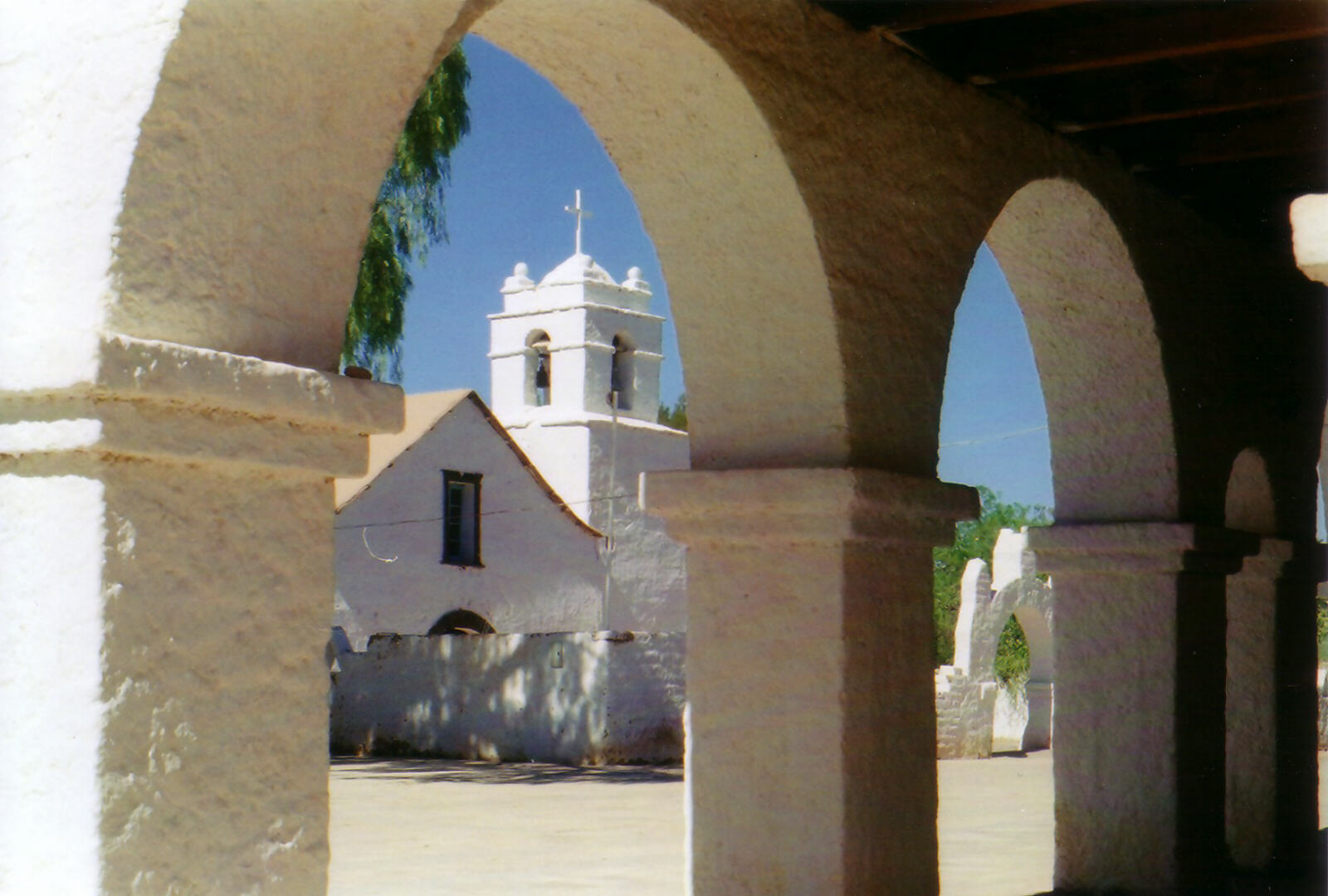
|
After finding a restaurant open for breakfast we pottered around in the sunshine then retired to the shade in the afternoon to read and doze.
Sun 19th Oct. After a relaxed lie-in, a bit more pottering round and a pleasant breakfast at La Estaka restaurant, we went and got the 11:30 bus through the endless grey-brown gravel of the Atacama desert to Argentina. Everything was fine on the Chilean side, but as soon as we crossed into Argentina it became a dirt road, and for several hours we rattled around inside the bus under a shower of dust. It was most unpleasant. |
Salta, Argentina
|
We finally arrived in Salta about midnight and let a tout take us to the Hotel el Pasaje, which was very pleasant for $10 including breakfast.
Mon 20th Oct. We were in Salta last year, so this 'joins up' our two South American overland expeditions. It was nice to walk around town feeling at home, changing money in the same bank, buying 'dulce de leche' ice cream at the same ice cream shop on the main square, booking our next few days' tours at the same travel agent. We went back to a wonderful delicatessen on Espania Street, inappropriately named 'Casa Moderna', with lovely old wooden shelves and counters groaning with meats and cheeses, and walls full of hundreds of bottles of wines and spirits. Since last year the rear part of the shop has become a café, and we had a really wonderful lunch of a selection of delicious continental ham, chorizo, salami and cheeses, with potent red wine and local dark beer. Argentina already seems more sophisticated, more European, than Peru and Chile. After that the afternoon was rather a haze. In the evening, still rather full after lunch, we went out looking for a salad, but Argentina is red-meat country - not one of the restaurants we looked at had any salads on the menu. Eventually we had a bowl of soup in a rather nice restaurant just off the main square, followed by empanadas and black beer in a little café right on the square. Total cost for evening meal for two was $7.
Tues 21st Oct. We went on a day trip to Cachi, through multi-coloured rocks in Obispo Canyon and cactus fields in the Parque National des Cardones (Cardones are a type of cactus). We saw condors soaring in the distance against the mountains. Cachi was a sweet, sleepy little village where we had lunch, and then came back. |
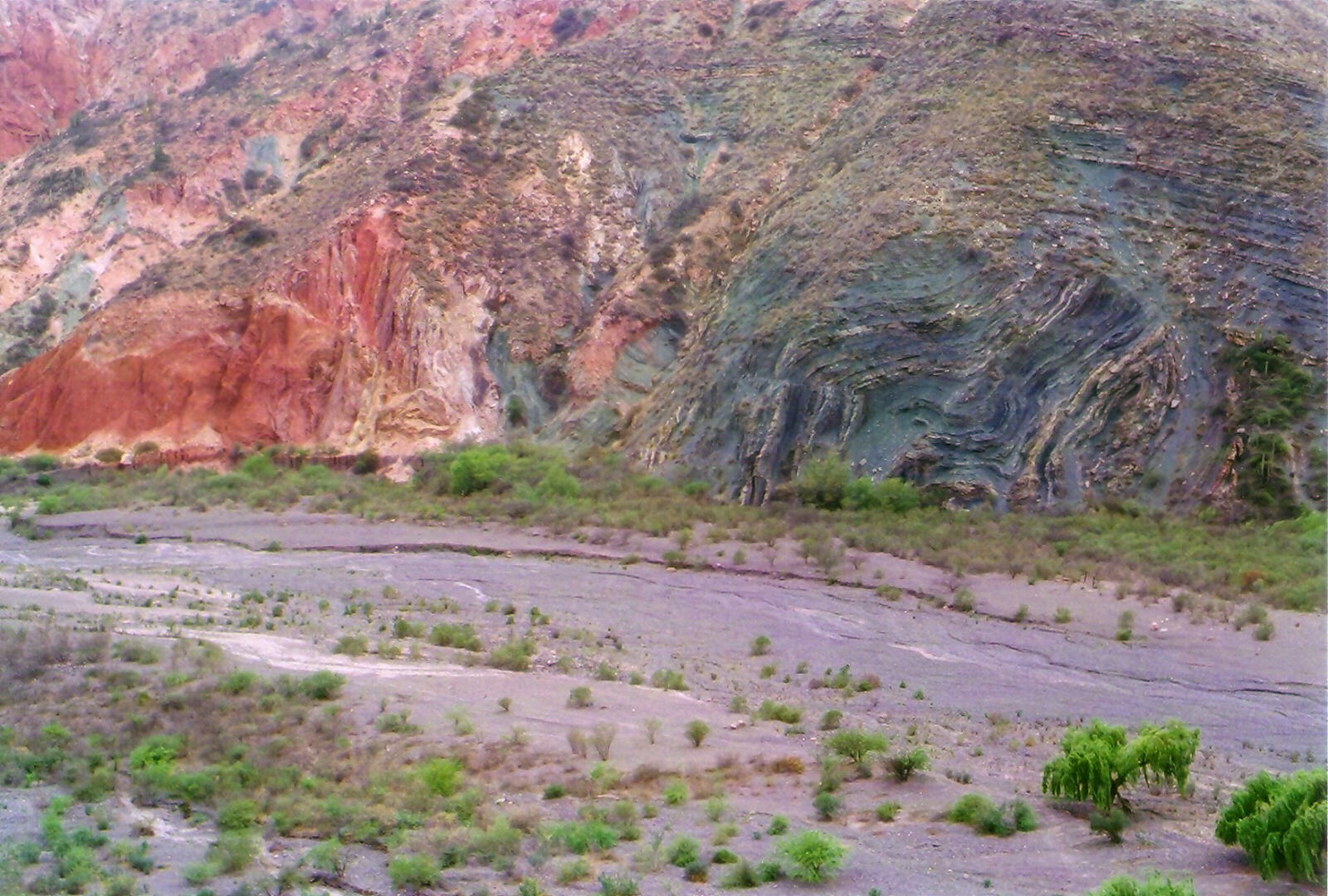
|
In the evening we had another fabulous plate of hams, salamis and cheeses at the Casa Moderna, again with potent red wine and black beer. We finally got the hot water working at the hotel and had wonderful hot showers.
Wed 22nd Oct. We went on a day trip to Humahuaca, through more spectacular multi-coloured canyons and picturesque little villages. In Humahuaca Canyon we visited Purmamarca village (first picture) and saw what appears to be a meteor crater in the colourful hillside (second picture). |
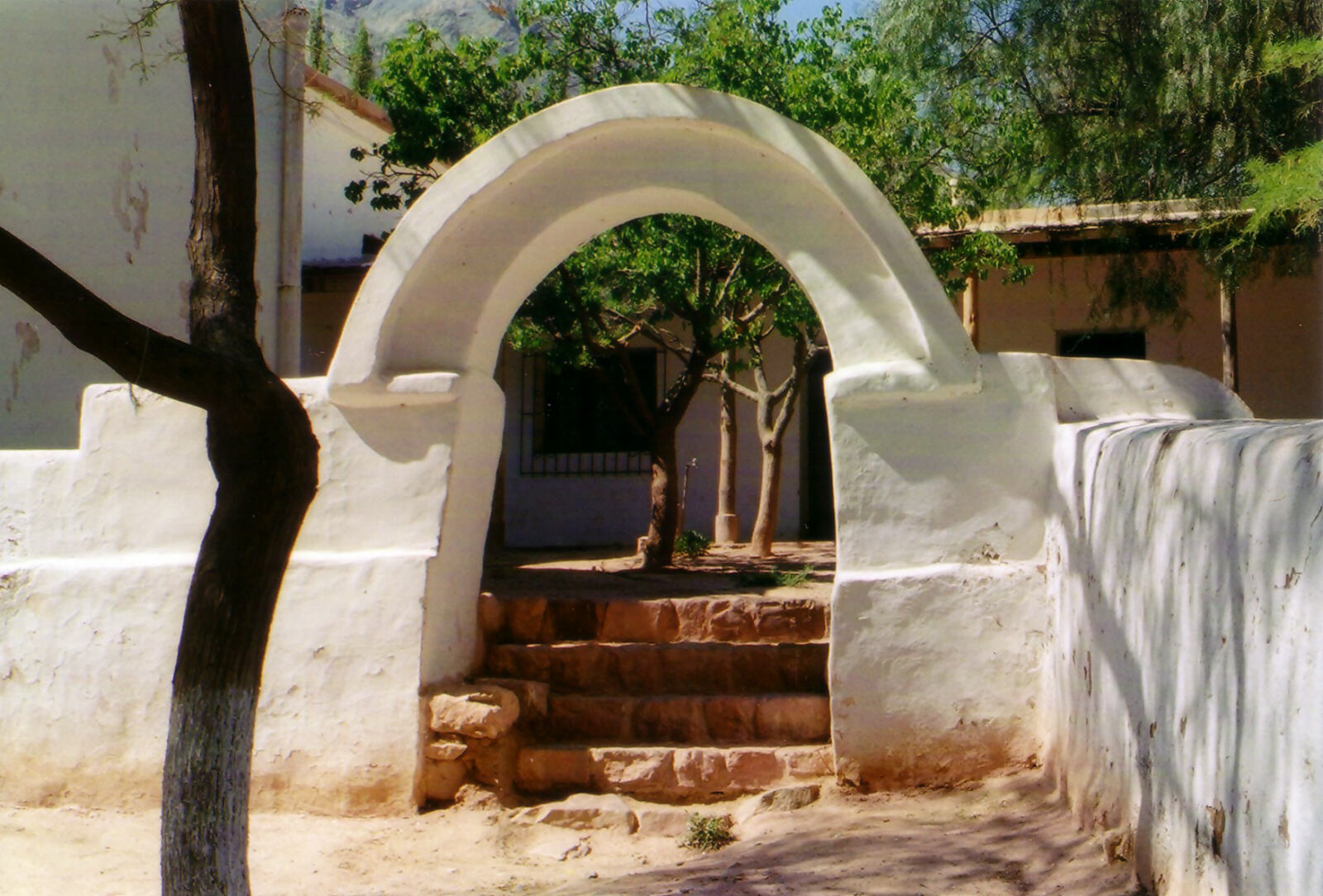
|
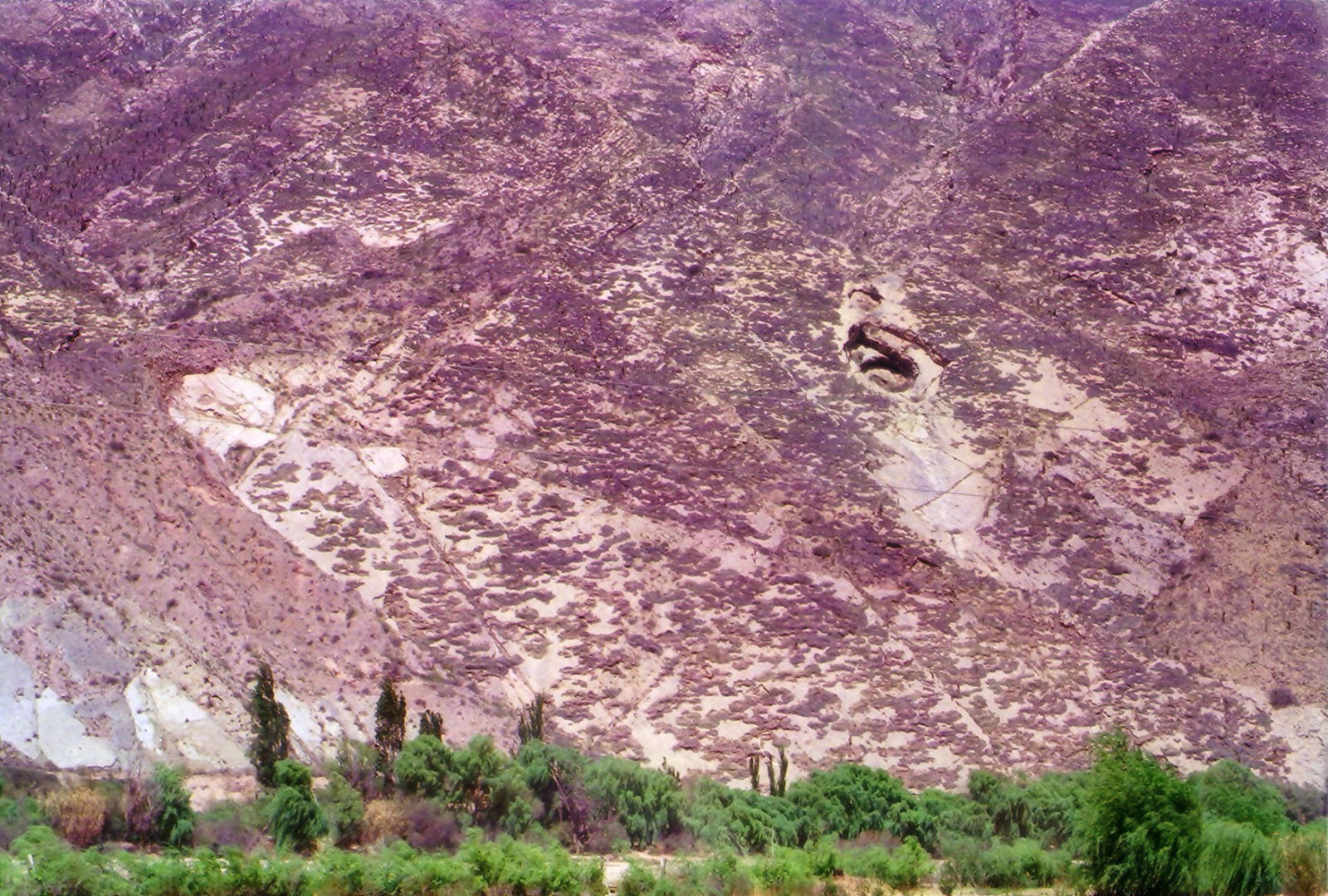
|
Our evening meal was at the very up-market José Balcarce restaurant, which was very good but not quite as wonderful as we remembered from last year. Maybe it's a mistake to go back; or maybe it was the other diners who were pumping cigar smoke into the room.
Thurs 23rd Oct. We caught the 7am El Indio bus to Cafayate, through yet another dramatic red-rock canyon with fantastic shapes and colours. After a brief coffee-stop on the way we arrived in Cafayate and found the lovely Hotel Los Sauces, where we had a room that opened onto the garden, with a view of palm trees and the cathedral bell tower. Cafayate is a wine-producing area, so we set about visiting the wine-associated sights. We went to the wine museum which was full of interesting old wine-making equipment and huge oak barrels, although the descriptions were only in Spanish. Then just down the road to the Domingo Brothers bodega (winery) where we had a guided tour, although nothing seemed to be happening, probably because it was lunch-time. So we went to a café on the main plaza for our standard lunch of salad, empanadas and wine or beer, and bumped into Christian, our tour guide from yesterday's tour to Humahuaca, who was doing the Cafayate tour today with a group including several of the people who were on yesterday's tour. It's a small world, although there are just a few well-trodden tourist paths so perhaps it's not so surprising. |
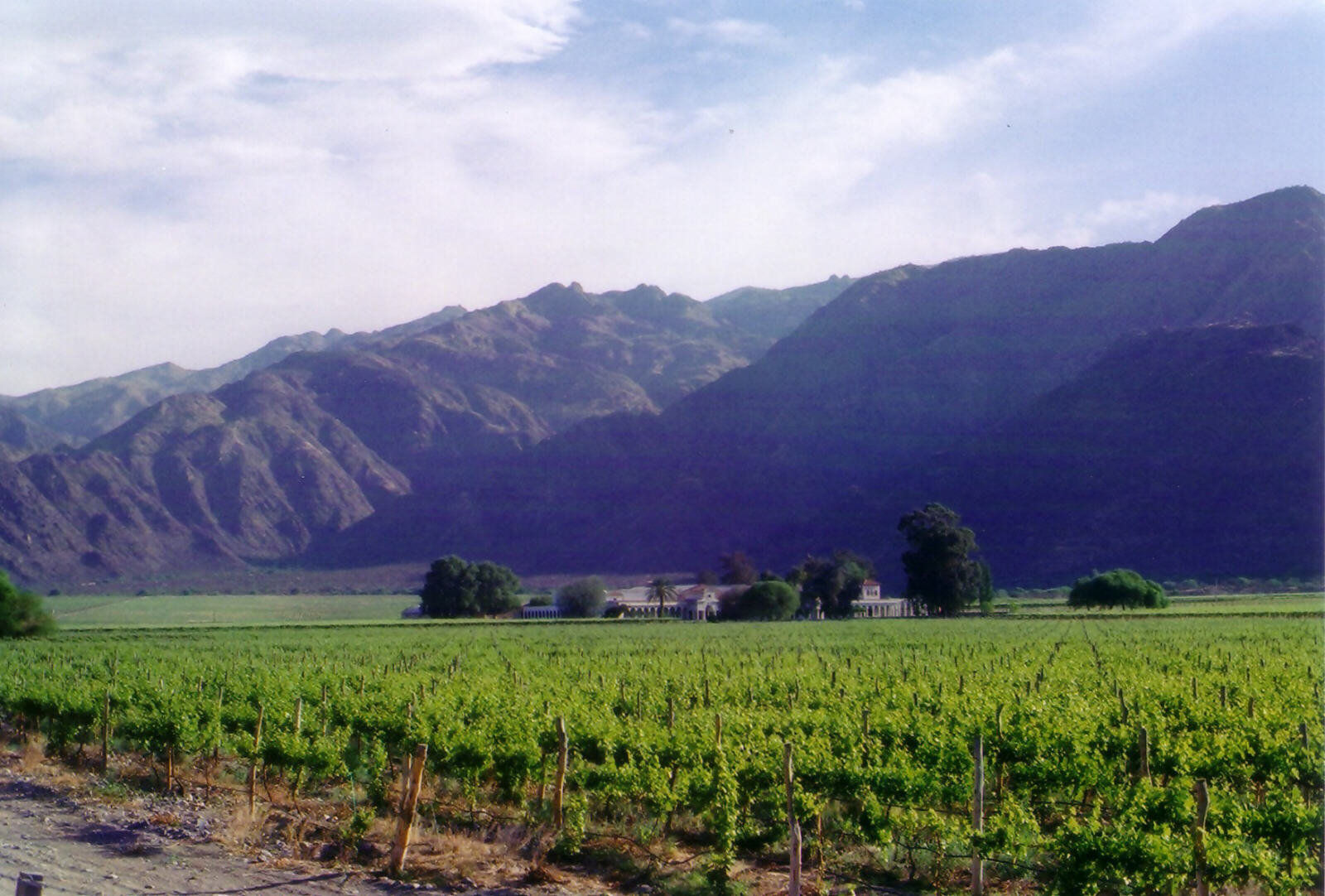
|
In the afternoon we went to the Bodega Etchart, in the middle of huge vineyards a couple of kilometres outside town. This was more like it - there were bottling machines and labelling machines clattering away, queues of bottles jostling each other on conveyor belts and a man with a fork-lift truck stacking great palettes loaded high with boxes of wine. Again we tried the wine tasting but again we didn't buy any - either our palates are not sophisticated enough or they don't give the good stuff to the tourists. For dinner we ate at 'The Ranch' restaurant on the main square. The menu was almost the same as all the other restaurants on the square, so we chose the nicest-looking one.
Fri 24th Oct. After a very good breakfast at Los Sauces hotel, we caught the bus back through the spectacular Cafayate canyon to Salta. |
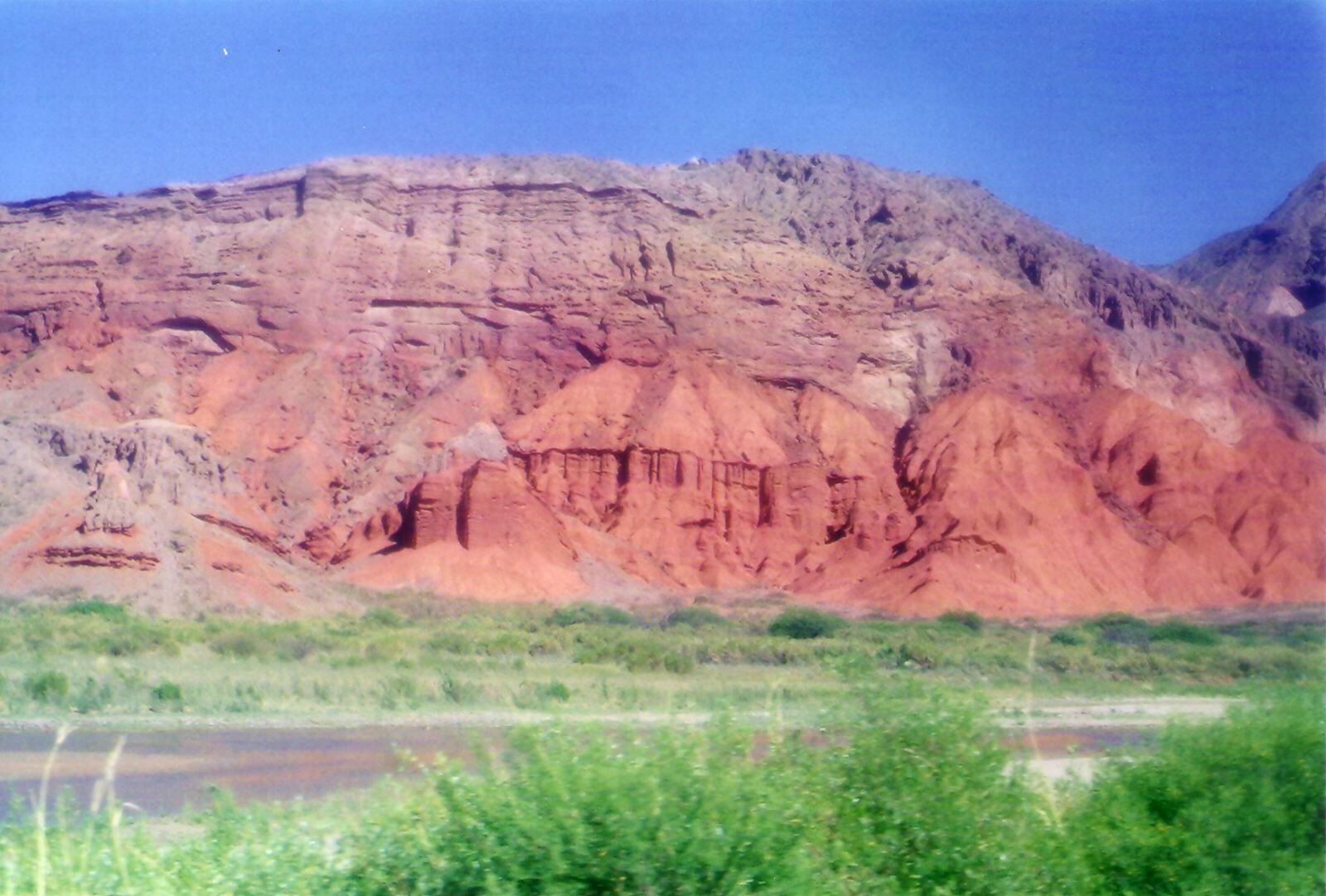
|
In Salta we had hoped as a treat to stay at the up-market Hotel del Virrey, in a lovely old colonial house, but it was full, so we went to the Colonial Hotel, a nice old-fashioned place right on the main square, where we stayed last year. There we got a room with balcony overlooking one of Salta's picturesque churches for $22. For lunch we sat at a café on the square and had beer and empanadas (of course) and chatted to a Welsh-American couple who had driven from Seattle to Salta in a big camper van. They had had to by-pass Colombia, paying over $6,000 and enduring long delays to ship from Panama to Lima. We strolled around a bit in the sunshine, read and dozed a bit in the heat of the afternoon and went back to Casa Moderna yet again for the same delicious dinner of hams, salamis and cheeses.
Sat 25th Oct. We had a look round Salta's bustling municipal market, which had dozens of spice stalls as well as the fruit and veg, fish, meat, etc, and also dozens of little lunch stalls mostly specialising in pizza. However, we spurned these and returned to Casa Moderna yet again for a final wonderful plate of the usual. The price varies between 32 and 35 pesos (about $11 - $12) which is great value. In the afternoon we caught the overnight bus to Buenos Aires. We thought we had booked the sleeper bus where the seats actually fold down flat, but it turned out to be 'semi-cama' with the normal reclining seats. After a brief disappointment we actually found it very comfortable, and managed to get quite a bit of sleep. We stopped three times for meals, two of which were quite good, and there were several videos although mercifully they kept the sound turned down. |
Buenos Aires, Argentina
|
Sun 26th Oct. We arrived at Buenos Aires bus station 22 hours later in good shape, enquired about buses to Mar del Plata, the Argentinians' seaside resort, and caught a taxi to the Victory Hotel. This had been recommended by the tour agent in Salta as being 'not very pretty' but very central and good value for about $22 for a room. His description was spot on and it suited us perfectly. We went for a walk round the shops and had a light lunch at a café (steak, of course, what else can you eat in Buenos Aires?). After that, more shopping and Sheila had her nails done (the first phase in a major reconstruction scheduled for the next few days). In the evening (and nothing starts in BA before 9pm) we went back to one of our favourite restaurants from last year, La Estancia. The steaks were still as huge, tender and tasty as last year and we weren't disappointed.
Mon 27th - Tues 28th Oct. Days at leisure in Buenos Aires. We took the metro and taxis to shopping malls, Sheila had a variety of repair work done - leg wax, hair do, nails, massage, pedicure, etc. One day we had a long lunch of hams and cheeses at Museo de Jamon. In the evening we had dinner at Grant's restaurant, still a huge buffet of 300 plates and 20 speciality cooked dishes for only $4 each (gone up just 1 peso since last year) and we splashed out on a bottle of champagne for $9. Everything is still ridiculously cheap here because of the favourable exchange rate. Another evening we sat at a pavement café having a few beers and watching the world go by. |
Mar del Plata, Argentina
|
Wed 29th Oct. As a change from all the bus journeys, we went to Mar del Plata by train. Leaving our bags at the hotel and 'travelling light' with just a rucksack we caught the metro to Constitution Station and caught the train, which went off on time at a good pace through the BA suburbs and crowded commuter stations which presumably keep this railway running, unlike so many in South America. The tickets cost $9 each in 'pullman' class (air conditioned) as opposed to $7 in normal class and the train was comfortable if a little run down (rather a lot of the windows were cracked as if people were in the habit of throwing stones at them). We went to the restaurant car for breakfast of ham sandwiches and coffee. After a while the scenery changed to fertile-looking farmland. When we arrived in Mar del Plata we got a taxi to the beach and started looking for a hotel. We soon found the very elegant and stylish Hermitage Hotel right on the seafront, which we thought would be way out of our price range but we got a very nice, big room on the third floor with a sea view for $30. |
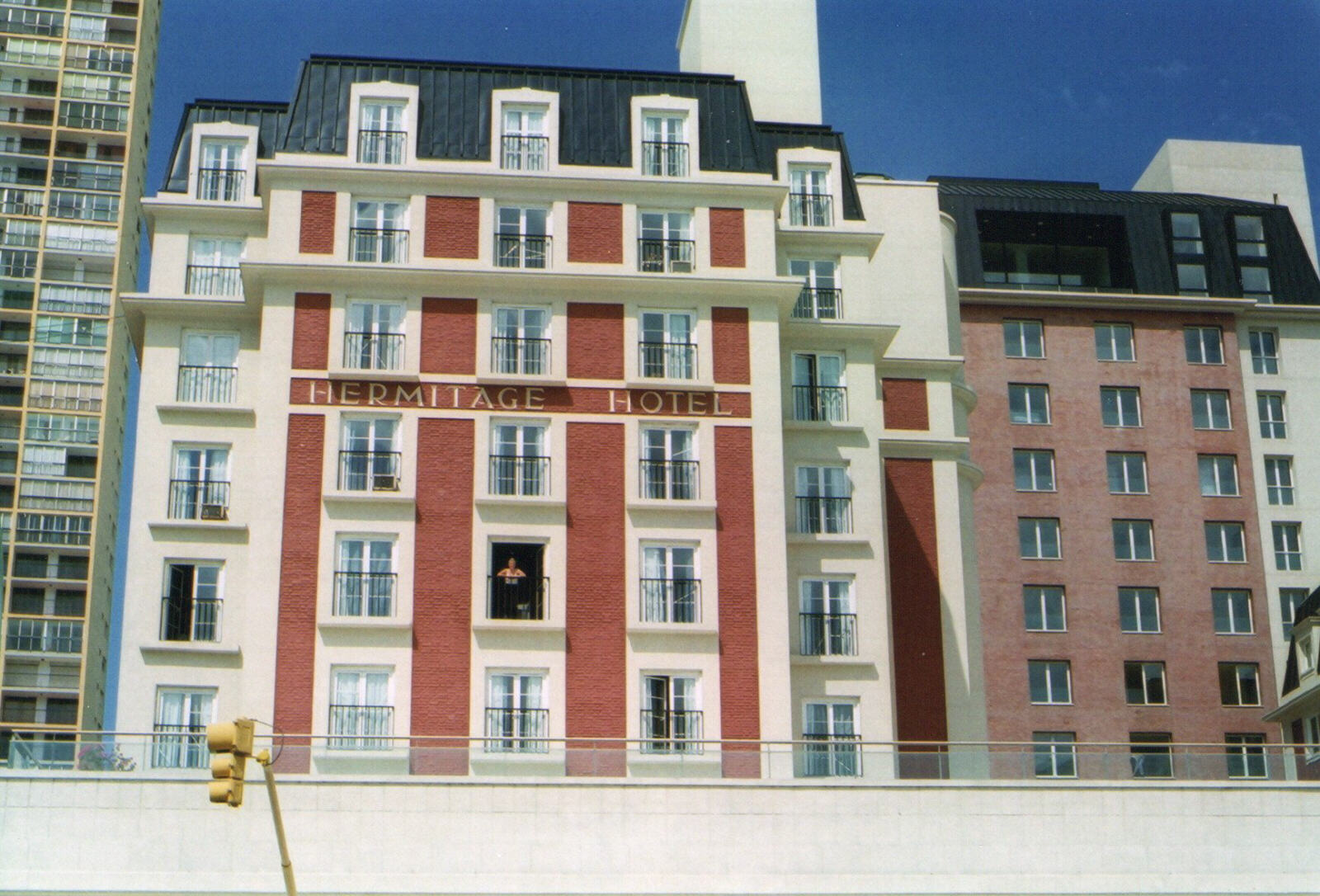
|
We walked round the town centre which was rather seaside-resort-ish, and had a snack in a fastfood restaurant. The guidebook mentioned a sea-lion colony out near the port so we went there by taxi, expecting to see a few distant sea-lion heads bobbing about in the water. What we found was a crowd of at least a hundred big, fat sea-lions sunning themselves on a rock, the nearest just six feet from where we were standing. They smelled awful but they were fascinating, always fidgeting, twitching a flipper here, snorting and sighing there, nudging each other out of the way and occasionally lumbering down to the sea to cool off. In the sea they were instantly transformed from lumbering, clumsy giants into sleek, fast, playful children. Eventually tearing ourselves away we walked through the fishing port where the last of the day's catch was being unloaded and a few more sea-lions were playing round the boats to get the last few scraps as they were thrown overboard. |
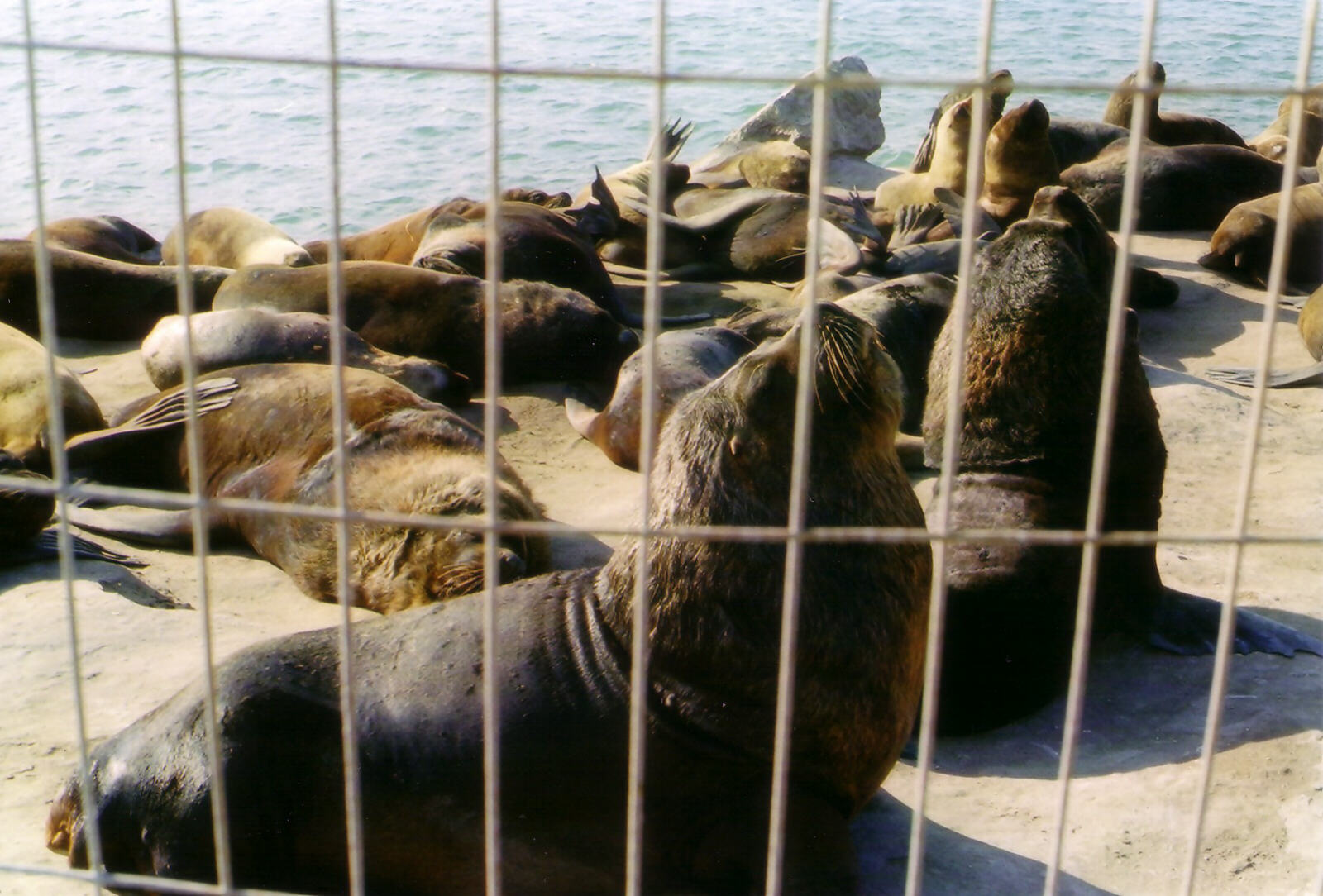
|
Nearby in the port we found a graveyard of ships rusting away.
|

|
We caught a bus back to the town centre (via every far-flung suburb of this surprisingly big town) and enquired at tourist information about good restaurants. The very helpful man there recommended the Trenque Lauquen, overlooking the sea. Sitting in a window seat there with a view round the bay below, we had a kebab - forget the takeaway version, this was the most tender, tasty Argentinian beef, it was delicious and huge - with champagne and followed by the ever-present dulce de leche ice cream.
Thurs 30th Oct. We strolled around Mardel in the morning and walked along the beach in the sunshine, arriving back at the Trenque Lauquen about 1pm. It was empty when we arrived and we got our favourite window seat again, but it rapidly filled up - obviously a favourite lunchtime spot. We had exactly the same meal as last night and it was still delicious. |
Buenos Aires again
|
By now it had clouded over and turned rather windy so we got the bus back to Buenos Aires. We turned up at the bus station and just got the last two seats on a bus leaving in five minutes. For some reason this was a 'suite' (sleeper) bus - big, comfy seats that reclined right back to a horizontal position. Sheila was in her element and slept much of the five-hour trip. It was raining by the time we arrived, so we sat inside, rather than outside, our favourite café and had black beer and peanuts for dinner. No matter how hard we tried we couldn't manage more than one big meal a day (although the black beer, red wine and champagne posed no such problem)!
Fri 31st Oct to Sun 2nd Nov. Sunny days in Buenos Aires. We went to various shopping malls and Sheila had more repair work at the masseuse and the hair stylist. She seems to have completely forgotten how to wash her own hair - is it me or does having your hair done three times in six days seem a bit over the top?
We went to the Recoletta district, walked round the pleasant square, found Evita's grave in the cemetery and ended up, of course, in the nearby shopping mall. We had a walk around the nicely-restored harbour and a look on one of the old ships (built in England in the 1890s). We had lunches at the Museo de Jamon and beers and sandwiches at our favourite street-corner café. We had evening meals at La Estancia preceded by Pisco Sours and Tia Marias at the same street café. On the last evening we went to a Tango show.
Mon 3rd Nov. We flew home. Incredibly, although our suitcases were full when we started, somehow we managed to fit in all Sheila's best buys - alpaca jumpers and llama gloves from Peru and a host of other souvenirs, to mention only the ones I was allowed to see, no doubt I will find out about the rest when the inevitable credit card bill comes in. |
Unfortunately customs confiscated these two llamas when we got back to England! |
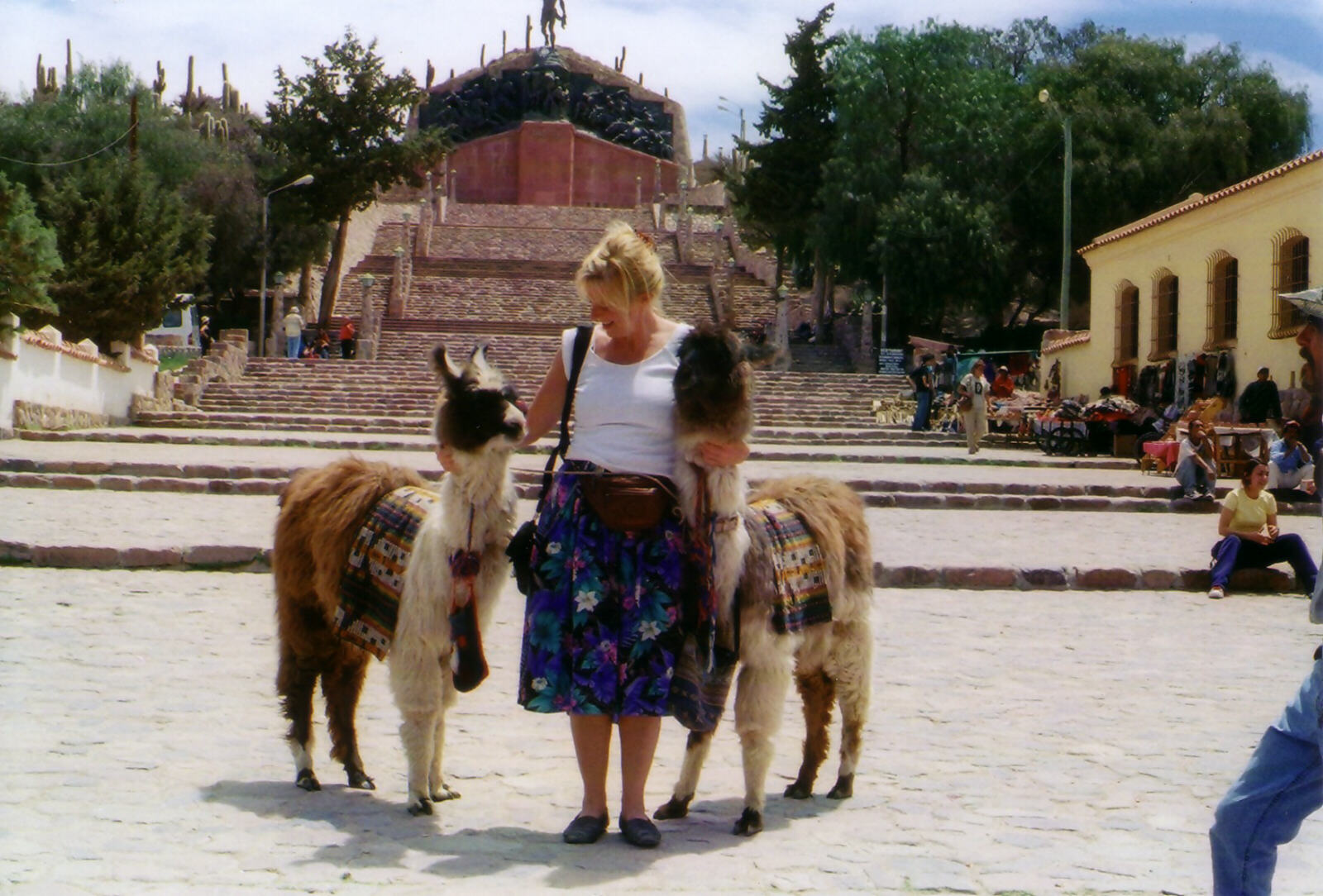
|
If you would like to see more of our travels just click the map.

|